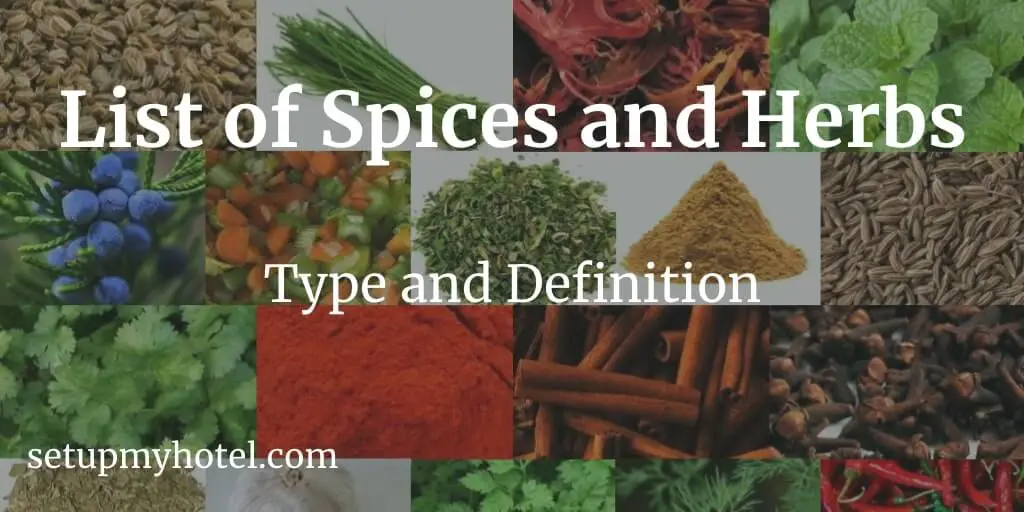Types and Definitions of Herbs and Spices Used in Hotel Kitchens
Spices: The term spice comes from Latin meaning ‘Fruits of the earth’. Spices, as distinguished from herbs, are derived from various parts of the plants. For example, Cinnamon is taken from the bark, cloves from the buds, saffrons from the flower, allspice from the fruit, ginger from the root, mustard from the seed, etc.
Herbs: Herbs are the second category of flavoring agents used in food, the term herbs comes from the Latin meaning ‘Grass’. Herbs are defined as the leaves and stems of soft-stemmed, non-woody plants. Examples are Savory, Sage, Thyme, Rosemary, Oregano etc.
Below you can find the list of most commonly used spices and herbs in the hotel kitchen department. All chefs should have a very good understanding and knowledge about the types of spices and their use in cooking.
1. All SpiceSpice - 1) Any number of aromatic vegetable products used to season or flavour food (eg: Cardamom; C... Berries
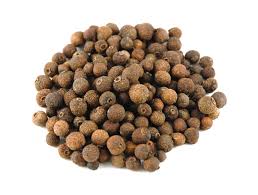
Allspice berries are the dried, unripe fruits of the Pimenta dioica plant, which is native to the Caribbean, Central America, and Mexico. Despite its name, allspice is not a blend of multiple spices but is a single spice that resembles a combination of flavors from cloves, cinnamon, and nutmeg. The flavor profile is warm, sweet, and slightly peppery.
Here are some key points about allspice berries:
- Flavor Profile: Allspice has a complex flavor that includes notes of cinnamon, cloves, and nutmeg. It’s often described as having a warm and sweet taste with a hint of pepper.
- Physical Appearance: The dried allspice berries are small, dark brown, and resemble large peppercorns. They have a wrinkled appearance.
- Common Uses: Allspice is a versatile spice used in both sweet and savory dishes. It is a key ingredient in many spice blends, such as Caribbean jerk seasoning. Allspice is also commonly used in baking, pickling, and in certain meat dishes.
- Culinary Applications:
- Baking: Allspice is frequently used in baking, especially in recipes for cakes, cookies, and pies.
- Savory Dishes: It complements the flavors of stews, curries, and marinades for meats, particularly in Caribbean and Middle Eastern cuisines.
- PicklingPickling is the practice of adding a sufficient amount of vinegar or lemon juice to a low-acid food ...: Allspice is sometimes used in pickling brines for fruits and vegetables.
- Substitutes: If you don’t have allspice, you can create a substitute by combining equal parts cinnamon, cloves, and nutmeg.
- Storage: Like other spices, allspice berries should be stored in a cool, dark place in an airtight container to preserve their flavor. Ground allspice has a shorter shelf life than whole berries.
Allspice is a wonderful addition to the spice repertoire, offering a unique and complex flavor that enhances a variety of dishes. Whether used in sweet or savory recipes, it contributes warmth and depth to the overall flavor profile.
- Type – Used as whole or ground.
- Characteristics – Small brown berry. The flavor resembles a combination of cinnamon, clove & nutmeg.
- Used in – Sausages, braises, eats, poached fish, cooked fruits, puddings, etc.
2. Anise / Star Anise
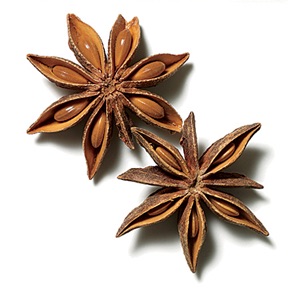
Anise and star anise are two distinct spices, each with its own unique flavor and appearance. While they share a similar name and have some flavor similarities, they come from different plants and are used in various culinary applications.
Anise:
- Plant Source: Anise (Pimpinella anisum) comes from the seeds of the anise plant, an herbaceous plant native to the eastern Mediterranean region and Southwest Asia.
- Flavor: Anise has a sweet and licorice-like flavor. The seeds are the most commonly used part in cooking.
- Culinary Uses:
- Anise is often used in both sweet and savory dishes.
- It is a common flavoring in desserts, pastries, and confectionery.
- Anise is also used in certain liqueurs, such as absinthe, and in some alcoholic beverages.
- Form: Anise is typically available as whole seeds or ground into a powder.
Star Anise:
- Plant Source: Star anise (Illicium verum) comes from the fruit of an evergreen tree native to Southeast Asia. The fruit is star-shaped, hence the name.
- Flavor: Star anise has a similar licorice flavor to anise, but it is generally stronger and more potent. The entire star, including the seeds, is used in cooking.
- Culinary Uses:
- Star anise is a common spice in Asian cuisines, particularly in Chinese and Vietnamese dishes.
- It is often used in soups, stews, and braises, imparting a rich and aromatic flavor.
- Star anise is a key ingredient in the Chinese five-spice powder.
- Form: Star anise is typically used whole. It can be added directly to dishes during cooking and is often removed before serving.
Distinction:
While anise and star anise share a similar flavor profile, they come from different plant sources. It’s important not to confuse the two, especially in recipes where the specific spice can significantly impact the flavor. If a recipe calls for one and you only have the other, you may need to adjust the quantity to achieve the desired taste.
- Type – Whole or ground spice.
- Characteristics – Licorice flavour, native to Spain, and China.
- Used in – Cookies, pastries, and bread.
3. Basil
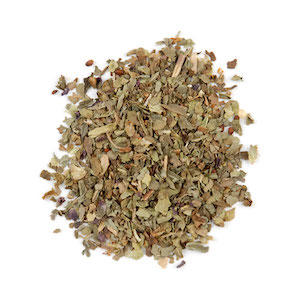
Basil is a popular culinary herb known for its fragrant leaves and versatile uses in various cuisines. There are different varieties of basil, each with its own unique flavor profile. Here are some key points about basil:
- Varieties:
- Sweet Basil (Ocimum basilicum): This is the most common variety and is often used in Italian cuisine, particularly in dishes like pesto, pasta sauces, and salads.
- Thai Basil (Ocimum basilicum var. thyrsiflora): Commonly used in Thai and other Southeast Asian cuisines, Thai basil has a slightly spicy, anise-like flavor.
- Lemon Basil (Ocimum basilicum var. citriodorum): As the name suggests, this basil variety has a lemony aroma and is used to add citrusy notes to dishes.
- Flavor Profile: Basil has a sweet, aromatic flavor with hints of pepper, mint, and anise. The intensity of the flavor can vary depending on the variety.
- Culinary Uses:
- Basil is a key ingredient in many Italian dishes, including pesto, tomato sauces, and Caprese salad.
- It complements the flavors of various vegetables, meats, and seafood.
- Thai basil is commonly used in stir-fries, curries, and noodle dishes in Southeast Asian cuisines.
- Basil is often added to salads, soups, and sandwiches for its fresh and aromatic quality.
- Storage:
- Fresh basil is best stored in the refrigerator. To extend its freshness, trim the stems and place the basil in a glass of water, covering the leaves loosely with a plastic bag.
- Basil can also be dried or frozen for longer-term storage, though the flavor may differ from fresh basil.
- Growing Basil:
- Basil is a relatively easy herb to grow. It thrives in well-drained soil with plenty of sunlight.
- Regular pruning of the leaves helps promote bushier growth and prevents the plant from flowering, which can affect the flavor of the leaves.
- Medicinal Uses:
- Basil has been traditionally used for its potential health benefits. It contains compounds with anti-inflammatory and antioxidant properties.
- Some cultures use basil in herbal teas for its calming effects.
Basil is a versatile herb that adds depth and aroma to a wide range of dishes. Whether used fresh or dried, it is a beloved ingredient in many cuisines around the world.
- Type – HerbHerb - A wide variety of aromatic plants used for seasoning and garnishing foods. Many of these plan... leaf, fresh or dried.
- Characteristics – Aromatic green leaf, member of the mint family. Can be grown fresh in warm weather
- Used in – Tomato dishes, pesto egg dishes, salads, marinades, fish, compound butter.
4. BayThe principal compartment; generally of a suite; that is the space equivalent of a standard guestroo... Leaf
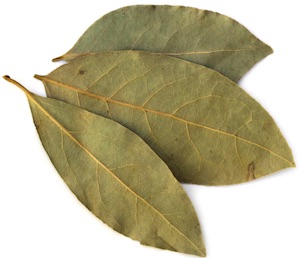
Bay leaves, also known as laurel leaves, are aromatic leaves from the bay laurel tree (Laurus nobilis). These leaves are widely used in cooking to add flavor to various dishes. Here are some key points about bay leaves:
- Flavor Profile: Bay leaves have a subtle, slightly floral, and aromatic flavor. They are not typically consumed but are added to dishes during cooking to infuse their flavor.
- Culinary Uses:
- Bay leaves are commonly used in soups, stews, sauces, and braises to enhance the overall flavor of the dish.
- They are often added to rice, pilafs, and certain meat dishes during cooking.
- Bay leaves are a key component of the French herb blend called “bouquet garni.”
- Form: Bay leaves are typically sold dried, as the fresh leaves can be quite strong and pungent. The dried leaves are glossy and dark green. They should be removed from the dish before serving, as they can be tough and may pose a choking hazard.
- Storage:
- Store bay leaves in a cool, dark place, away from direct sunlight, to preserve their flavor.
- Dried bay leaves have a long shelf life, but over time, they may lose some of their potency. It’s a good idea to replace them every year or so.
- Medicinal Uses:
- In traditional medicine, bay leaves have been used for their potential health benefits, including anti-inflammatory and digestive properties.
- Some cultures use bay leaf tea for its calming effects.
- Caution:
- While bay leaves are safe to use in cooking, they are not meant to be eaten as they can be tough and may cause discomfort if ingested.
- Type – Whole leaf herb.
- Characteristics – Stiff, dark green, oblong leaf, pungent aroma. Comes from Laurel tree
- Used in – Stocks, soups, sauces, RoastRoast - To cook food by surrounding it with dry heat. or BraisedBraised - Browned in a small amount of fat. meat etc.
When using bay leaves in cooking, it’s essential to remember that their role is to impart flavor during the cooking process rather than being consumed. Adding one or two bay leaves to a dish can enhance its aroma and taste. Always remove bay leaves before serving the final dish, as they can be a choking hazard and are not pleasant to eat due to their tough texture.
5. Bouquet GarniBouquet Garni - Fresh herbs of various types; tied together and used as a flavouring agent. Used for...
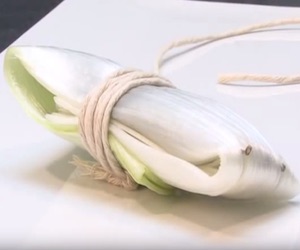
A “bouquet garni” is a bundle of fresh herbs tied together or placed in a piece of cheesecloth, used to add flavor to soups, stews, sauces, and various dishes. The term “bouquet garni” translates to “garnished bouquet” in French. It typically consists of a combination of herbs and, sometimes, other aromatics. The bouquet garni is added to the cooking liquid during the preparation of a dish, and it imparts its flavors while remaining easy to remove before serving.
Here’s a basic recipe for a traditional bouquet garni:
Ingredients:
- Fresh sprigs of parsley
- Fresh sprigs of thyme
- Bay leaves
Instructions:
- Gather the Herbs: Take a handful of fresh parsley, a few sprigs of thyme, and a couple of bay leaves.
- Tie or Bundle: Tie the herbs together with kitchen twine, or bundle them in a piece of cheesecloth and secure with twine. Creating a bundle allows the herbs to infuse the dish with flavor without leaving loose leaves or stems.
- Usage: Add the bouquet garni to soups, stews, sauces, or any dish where you want to infuse herbal flavors. It’s typically added at the beginning of the cooking process.
- Removal: Once the dish is cooked, remove the bouquet garni before serving. This is easily done since all the herbs are tied together.
Variations:
- Additional Herbs: Depending on the recipe and personal preferences, other herbs like rosemary, marjoram, or tarragon may be included.
- Aromatics: Sometimes, whole garlic cloves, celery stalks, or leek greens are added to the bouquet garni for additional flavor.
- Type – Flavouring MixMix - Method of combining ingredients in such a way that the parts of each ingredient are evenly dis....
- Characteristics – A personal selection of herbs, vegetables, and occasionally spices, often tied with a string.
- Used in – Stock, Soups, Sauces etc.
The bouquet garni allows for easy removal of herbs, preventing them from dispersing throughout the dish and making it convenient for the cook. It imparts a subtle and well-balanced herbal flavor to the dish without overpowering it. Different cuisines may have variations of the bouquet garni, and it is a classic technique in French cooking.
6. Caraway
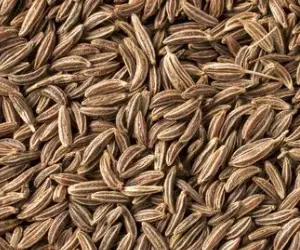
Caraway (Carum carvi) is a biennial plant belonging to the Apiaceae family, which also includes other aromatic herbs like parsley and dill. The plant is native to Western Asia, Europe, and North Africa. The seeds of the caraway plant are the most commonly used part in cooking and are known for their distinctive flavor. Here are some key points about caraway:
- Flavor Profile: Caraway seeds have a warm, earthy, and slightly sweet flavor with a hint of citrus and anise. The flavor is aromatic and unique, making caraway a popular spice in various culinary applications.
- Culinary Uses:
- Baking: Caraway seeds are commonly used in the baking of bread, particularly rye bread, where they contribute to the distinctive flavor.
- SauerkrautSauerkraut (sau-erkraut) - It's a 'sour cabbage' dish which is finely cut raw cabbage that has been ...: Caraway is often used in the preparation of sauerkraut, a fermented cabbage dish.
- Spice Blends: It is a key ingredient in certain spice blends, such as caraway seed blends and the Middle Eastern spice mix called “za’atar.”
- Meats: Caraway seeds pair well with meats, especially pork and beef, and are used in various meat dishes.
- Appearance: Caraway seeds are small, elongated, and curved. They have a brown color with a ridged texture.
- Health Benefits:
- Caraway has been traditionally used for its potential digestive benefits, including relieving indigestion and bloating.
- Some cultures use caraway seeds to prepare herbal teas for their mild medicinal properties.
- Storage:
- Store caraway seeds in a cool, dark place in an airtight container to preserve their flavor.
- Ground caraway can lose its potency more quickly than whole seeds, so it’s often recommended to grind the seeds just before use.
- Cultural Uses:
- Caraway is used in various cuisines, including European, Middle Eastern, and Indian cuisines.
- In traditional European dishes, caraway is often associated with hearty and savory flavors.
- Type – Whole Spice, Seed.
- Characteristics – Dark Brown, Curved seed. Grown in Northern Europe.
- Used in – Rye bread, cabbage, sauerkraut, and Other European Cuisine.
Caraway is a versatile spice that adds depth and warmth to a variety of dishes. Whether used in bread, sauerkraut, or meat dishes, its distinctive flavor is a unique and welcome addition to many culinary creations.
7. Cardamom
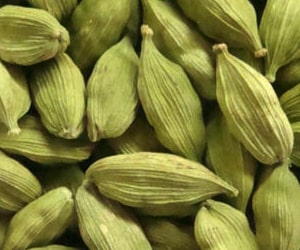
Cardamom is a spice that comes from the seeds of plants belonging to the genera Elettaria and Amomum, both in the ginger family (Zingiberaceae). There are two main types of cardamom: green cardamom (Elettaria cardamomum) and black cardamom (Amomum subulatum or Amomum costatum). Here are some key points about cardamom:
Green Cardamom (Elettaria cardamomum):
- Flavor Profile: Green cardamom has a unique, warm, and sweet flavor with citrus undertones. It is considered one of the most aromatic and flavorful spices.
- Common Uses:
- Green cardamom is a key ingredient in many sweet dishes, desserts, and beverages.
- It is often used in Indian, Middle Eastern, and Scandinavian cuisines.
- Commonly used in chai tea, desserts, and spiced rice dishes.
- Appearance: The small, green pods contain tiny black seeds. Both the pods and the seeds are used in cooking.
Black Cardamom (Amomum subulatum or Amomum costatum):
- Flavor Profile: Black cardamom has a smoky and bold flavor with a hint of camphor. It is less sweet than green cardamom.
- Common Uses:
- Black cardamom is often used in savory dishes, particularly in Indian and Southeast Asian cuisines.
- It is a key ingredient in spice blends like garam masala.
- Used in meat dishes, curries, and certain rice preparations.
- Appearance: The pods of black cardamom are larger and darker than green cardamom. The seeds inside are also darker.
Culinary Uses:
- Beverages: Cardamom is a common spice in beverages, including chai tea, coffee, and various herbal teas.
- Baking: Both green and black cardamom are used in baking, adding flavor to cookies, cakes, and pastries.
- Curries and Stews: Cardamom is a staple in many spice blends used in curries and stews, providing depth and complexity to the flavor.
- Desserts: Cardamom is often used in desserts like rice puddings, ice creams, and fruit-based dishes.
- Aromatic Rice: Cardamom is frequently used to flavor rice dishes, adding fragrance and taste.
Storage:
- Store both green and black cardamom in airtight containers away from heat and sunlight to preserve their flavor.
- Ground cardamom loses its flavor more quickly than whole pods, so it’s often recommended to grind the seeds just before use.
- Type – Whole pod or ground seed spice.
- Characteristics – Tiny brown seeds, white on green pods, sweet & aromatic expensive. Origin or Native of India & Guatemala.
- Used in – Pickling, Danish pastries, curries etc.
Cardamom is a versatile spice that adds a delightful and exotic flavor to a wide range of dishes. Its distinct taste makes it a favorite in various culinary traditions around the world.
8. CayenneVery strong kind of pepper which must be used sparingly. often offered with oysters.
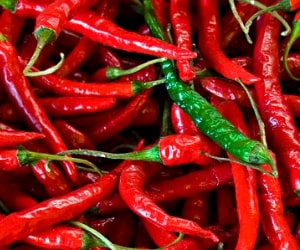
Cayenne pepper, also known as red pepper or Guinea spice, is a hot chili pepper that belongs to the Capsicum annuum species. It is named after the city of Cayenne in French Guiana. Cayenne pepper is well-known for its fiery heat and is commonly used as a spice in various cuisines. Here are some key points about cayenne:
Flavor Profile:
- Heat: Cayenne pepper is hot and pungent due to the presence of capsaicin, the compound responsible for the spiciness in chili peppers.
- Flavor: It has a bright, slightly fruity, and smoky flavor that adds depth to dishes.
Culinary Uses:
- SeasoningSeason / Seasoning - 1) To enhance the flavour by the addition of salt or other ingredients. 2) To m...: Cayenne is often used as a seasoning to add heat to a wide range of dishes, including soups, stews, sauces, and marinades.
- Spice Blends: It is a common ingredient in spice blends like Cajun seasoning and curry powder.
- Hot Sauces: Cayenne is a primary ingredient in many hot sauces, contributing both heat and flavor.
- Dry Rubs: Cayenne is used in dry rubs for meats, providing a spicy kick to barbecue and grilled dishes.
- Beverages: Some people add a pinch of cayenne to beverages like hot chocolate or certain cocktails for a spicy twist.
Health Benefits:
- Metabolism: Capsaicin in cayenne has been linked to a temporary increase in metabolism, making it a component in some weight-loss supplements.
- Pain Relief: Capsaicin is also used topically in some creams for pain relief, particularly for conditions like arthritis.
Usage Tips:
- Caution: Cayenne is very hot, so it’s wise to start with a small amount and adjust to taste. Be careful when handling it, and avoid touching your face or eyes after handling cayenne without washing your hands thoroughly.
- Gradual Addition: When cooking, it’s often best to add cayenne gradually and taste as you go to control the level of spiciness.
Storage:
- Whole or Ground: Cayenne is available in both whole dried form (as red chili peppers) and ground form. Store in a cool, dark place in airtight containers to maintain freshness.
- Shelf Life: Ground cayenne pepper can lose its potency over time, so it’s a good idea to replace it periodically.
- Type – Ground spice, seed.
- Characteristics – Ground hot red pepper. Very powerful. A native of French Guiana.
- Used in – Very small amounts in soups, sauces, fish, egg, etc.
Cayenne pepper adds not only heat but also a distinctive flavor to a variety of dishes. It’s a versatile spice that can be used to enhance both savory and sweet dishes, providing a kick that many spice enthusiasts appreciate.
9. Celery Seed
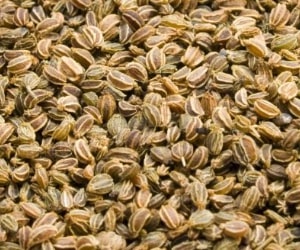
Celery seed comes from the wild celery plant, Apium graveolens, which is related to the celery vegetable. The seeds are small and brown, with a strong, concentrated flavor reminiscent of celery. Here are some key points about celery seed:
Flavor Profile:
- Flavor: Celery seeds have a robust, earthy, and slightly bitter taste, similar to the flavor of celery but more concentrated.
- Aroma: The seeds emit a strong and aromatic fragrance when crushed.
Culinary Uses:
- Spice Blends: Celery seed is a common ingredient in spice blends, such as celery salt and pickling spice.
- Soups and Stews: It is used to add depth and a celery-like flavor to soups, stews, and casseroles.
- Salad Dressings: Celery seed is often included in salad dressings, providing a unique and tangy flavor.
- Pickling: The seeds are commonly used in pickling, particularly for pickles and various preserved vegetables.
- Bread and Baking: Celery seed can be used in bread, rolls, and savory baked goods for added flavor.
Health Benefits:
- Anti-Inflammatory Properties: Celery seed has been traditionally used for its potential anti-inflammatory properties.
- Antioxidants: It contains antioxidants that may contribute to health benefits.
Usage Tips:
- Intensity: Celery seed has a potent flavor, so use it sparingly and adjust according to taste.
- Substitutes: If you don’t have celery seed, you can use celery salt, although you may need to adjust the salt content in your recipe.
Storage:
- Cool and Dark: Store celery seeds in a cool, dark place to preserve their flavor.
- Airtight Container: Keep them in an airtight container to prevent moisture and maintain freshness.
- Type – Whole or ground spice, seed.
- Characteristics – Tiny brown seed, with strong celery flavor. Too much can create a hot spice effect.
- Used in – Salads, dressings, pickling, tomato dishes, marinades, etc.
Celery seed is a versatile spice that can add a distinctive flavor to various dishes. It is particularly valued for its ability to provide a celery-like taste without the bulk of fresh celery. Whether used in spice blends, pickling, or cooking, celery seed contributes a unique and robust flavor to culinary creations.
10. Chervil

Chervil (Anthriscus cerefolium) is an herb that is part of the parsley family (Apiaceae). It is known for its delicate, lacy leaves and mild, slightly sweet flavor with hints of anise. Chervil is often used in French cuisine and is one of the classic fines herbes, a mixture of fresh herbs that also includes parsley, tarragon, and chives. Here are some key points about chervil:
Flavor Profile:
- Taste: Chervil has a delicate and subtle flavor with a hint of anise or licorice. Its flavor is milder compared to some other herbs, making it a popular choice for dishes where a light touch is desired.
Culinary Uses:
- Fines Herbes: Chervil is a key component of the classic French herb blend called fines herbes, used to flavor delicate sauces, omelets, and soups.
- GarnishGarnish - The artistic complementing of a food item with other food or edible item.: Chervil is often used as a garnish for its attractive appearance. It is particularly suitable for adding a finishing touch to dishes like salads, seafood, and roasted vegetables.
- Sauces: It is used in sauces, especially in combination with butter-based sauces, to add a fresh and aromatic element.
- Egg Dishes: Chervil pairs well with eggs, making it a great addition to scrambled eggs, frittatas, and quiches.
Appearance:
- Leaves: Chervil leaves are fine and feathery, resembling flat-leaf parsley but more delicate. They have a bright green color.
Storage:
- Fresh: Chervil is best when used fresh. Store it in the refrigerator, wrapped in a damp paper towel and placed in a plastic bag, to maintain its freshness.
Caution:
- Cooking: Chervil is delicate and loses its flavor when exposed to prolonged heat, so it’s often added towards the end of the cooking process or used as a finishing touch.
- Type – Herb leaf, fresh or dried.
- Characteristics – Mild flavor of parsley and tarragon.
- Used in – Soups, salads, sauces, egg dishes, chicken, fish, dressing, etc.
Chervil is a versatile herb that adds a touch of freshness and elegance to various dishes. Its unique flavor profile makes it a favorite in French cuisine and a valuable addition to a variety of recipes, particularly those requiring finesse and subtlety.
11. Chili Powder
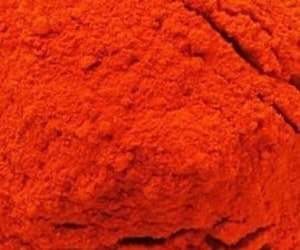
Chili powder is a spice blend made from ground dried chili peppers along with other complementary spices. The exact composition of chili powder can vary, and different regions or brands may have their own specific blends. Here are some key points about chili powder:
Composition:
- Chili Peppers: The primary ingredient in chili powder is ground dried chili peppers. The type of chili peppers used can vary, and it contributes to the heat level and flavor profile of the powder.
- Complementary Spices: In addition to ground chili peppers, chili powder often contains other spices such as cumin, garlic powder, onion powder, paprika, and oregano. The combination of these spices adds complexity to the flavor.
Culinary Uses:
- Seasoning: Chili powder is a common seasoning used in various cuisines to add heat and flavor to dishes.
- Chili Recipes: It is a key ingredient in chili con carne and other chili recipes, providing both color and spiciness.
- Mexican and Tex-Mex Cuisine: Chili powder is frequently used in Mexican and Tex-Mex dishes, including tacos, enchiladas, and salsas.
- Marinades and Rubs: It can be used as part of marinades or dry rubs for meats, adding a spicy kick.
- Beans and Soups: Chili powder is often added to bean dishes, soups, and stews to enhance their flavor.
Heat Level:
- The heat level of chili powder can vary based on the types of chili peppers used. Some blends may be milder, while others can be quite hot.
Types of Chili Powder:
- Ancho Chili Powder: Made from dried and ground poblano peppers, it has a mild to moderate heat level and a slightly sweet, smoky flavor.
- Chipotle Chili Powder: Made from smoked and dried jalapeño peppers, it has a moderate to high heat level with a smoky flavor.
Storage:
- Store chili powder in a cool, dark place in an airtight container to maintain its freshness.
- Type – Ground spice or blend.
- Characteristics – BlendBlend - To mix two or more ingredients so completely that they lose their separate identities. of ground cumin, chili pepper, oregano, allspice.
- Used in – Chili, Stews, sauces, ground meat etc.
Chilli powder is a versatile spice blend that adds both heat and flavor to a variety of dishes. Its popularity extends across different cuisines, making it a staple in many kitchens around the world.
12. Chives
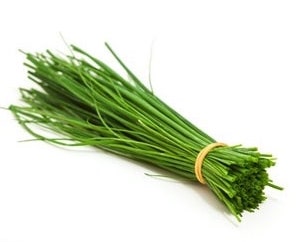
Chives (Allium schoenoprasum) are a popular herb that belongs to the onion family. Known for their mild onion flavor, chives are characterized by their long, slender, green stems. They are commonly used as a fresh herb to add a subtle onion taste to various dishes. Here are some key points about chives:
Flavor Profile:
- Taste: Chives have a mild onion flavor, but it is much milder compared to other members of the Allium family, such as onions and garlic.
- Aroma: Chives have a delicate and fresh aroma.
Culinary Uses:
- Garnish: Chives are often used as a garnish to add a burst of color and flavor to dishes.
- Salads: They are a popular addition to salads, providing a mild onion flavor without overpowering other ingredients.
- Potatoes: Chives pair well with potatoes, whether sprinkled over baked potatoes, mashed potatoes, or potato salads.
- Eggs: Chopped chives are commonly used to enhance the flavor of omelets, scrambled eggs, and quiches.
- Soups and Sauces: Chives can be stirred into soups and creamy sauces just before serving to add a fresh and mild onion taste.
Appearance:
- Stems: Chive stems are long, thin, and hollow. They are typically bright green in color.
Storage:
- Fresh: Chives are best when used fresh. Store them in the refrigerator, either wrapped in a damp paper towel and placed in a plastic bag or upright in a glass of water like cut flowers.
Health Benefits:
- Chives contain vitamins, minerals, and antioxidants, and they are a low-calorie herb.
Culinary Substitutes:
- If fresh chives are not available, you can use green onions or scallions as a substitute in many recipes.
- Type – Fresh, Dried, frozen.
- Characteristics – Fine, hollow, green top of a very small onion.
- Used in – Salads, egg * cheese dishes, fish soups, and sauces.
Chives are a versatile and widely used herb that can be enjoyed in both savory and some mildly sweet dishes. They bring a subtle onion flavor to various recipes without overwhelming the palate, making them a favorite among cooks and chefs alike.
13. Cilantro
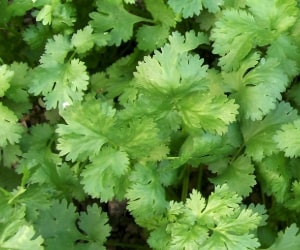
Cilantro, also known as coriander leaves or Chinese parsley, is an herb with bright green, delicate leaves and a fresh, citrusy flavor. Both the leaves and stems of the cilantro plant are edible, and they are commonly used in various culinary traditions around the world. Here are some key points about cilantro:
Flavor Profile:
- Taste: Cilantro has a distinctive flavor that is often described as fresh, citrusy, and slightly peppery.
- Aroma: It has a bright and aromatic fragrance.
Culinary Uses:
- Salsas and Guacamole: Cilantro is a key ingredient in many salsas and guacamole, contributing to their fresh and vibrant flavors.
- Asian Cuisine: It is commonly used in Asian dishes, such as Thai curries, Vietnamese pho, and Indian chutneys.
- Mexican Cuisine: Cilantro is a staple in Mexican cuisine, used in tacos, enchiladas, and various sauces.
- Garnish: Cilantro is often used as a garnish for soups, salads, and main dishes to add color and flavor.
- Marinades: It is a common ingredient in marinades for meats and seafood, infusing them with its bright and aromatic notes.
Appearance:
- Leaves and Stems: The leaves are finely divided, and the stems are thin and tender.
Storage:
- Fresh: To store fresh cilantro, trim the stems, place the bunch in a jar with water like flowers, cover the leaves loosely with a plastic bag, and store it in the refrigerator. Alternatively, you can wrap it in a damp paper towel and place it in a plastic bag.
Culinary Substitutes:
- If cilantro is unavailable or disliked, some people use parsley as a substitute, though it has a different flavor profile.
Culinary Controversy:
- Cilantro is known to have a polarizing effect; some people love its fresh flavor, while others find it has a soapy or unpleasant taste. This is thought to be influenced by genetic factors.
- Type – Leaf herb, dried or fresh.
- Characteristics – Light green aromatic leaf. The shape of flat parsley but much more pungent flavor. Leaf taken from coriander seeds.
- Used in – Salads, salsa, sauces, soups, dressing, etc.
Cilantro adds a vibrant and fresh element to a wide range of dishes, making it a versatile herb in many cuisines. It is valued for its ability to brighten and enhance the flavors of various recipes.
14. Cinnamon
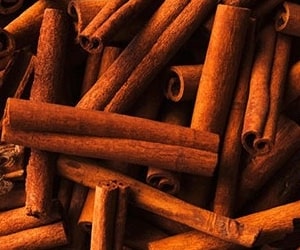
Cinnamon is a popular spice that comes from the bark of trees belonging to the Cinnamomum genus. There are several species of cinnamon, but two primary types are commonly used: Ceylon cinnamon (Cinnamomum verum) and Cassia cinnamon (Cinnamomum cassia). Here are some key points about cinnamon:
Flavor Profile:
- Taste: Cinnamon has a warm, sweet, and slightly spicy flavor.
- Aroma: It has a rich and aromatic fragrance.
Types of Cinnamon:
- Ceylon Cinnamon (True Cinnamon): This type is considered “true” cinnamon and is often referred to as Ceylon cinnamon because it is primarily produced in Sri Lanka. It has a more delicate and subtly sweet flavor.
- Cassia Cinnamon: Cassia cinnamon is the more common variety and is often labeled simply as “cinnamon” in most countries. It has a stronger and more intense flavor compared to Ceylon cinnamon.
Culinary Uses:
- Baking: Cinnamon is a classic spice used in baking for various desserts, including cinnamon rolls, apple pie, and cookies.
- Hot Beverages: It is a common addition to hot beverages such as coffee, tea, and hot chocolate.
- Spice Blends: Cinnamon is a key ingredient in many spice blends, including pumpkin spice and chai spice.
- Sauces and Stews: In some cuisines, cinnamon is used in savory dishes, particularly in Middle Eastern and North African cuisines. It adds depth to sauces, stews, and rice dishes.
Health Benefits:
- Antioxidant Properties: Cinnamon contains antioxidants that may help protect the body’s cells from damage.
- Anti-Inflammatory Effects: Some studies suggest that cinnamon may have anti-inflammatory effects.
Forms:
- Ground Cinnamon: It is the most common form and is made by grinding cinnamon sticks into a powder.
- Cinnamon Sticks: Whole sticks can be used for infusing liquids or in recipes where the spice is meant to be removed before serving.
Storage:
- Store cinnamon in a cool, dark place in an airtight container to preserve its flavor.
- Type – Stick or ground spice.
- Characteristics – Aromatic bark from cinnamon or cassia tree with a reddish brown color. A native of India.
- Used in – Preserves, stewed fruits, bread, pastries, desserts, ham, hot beverages.
Cinnamon is a versatile spice that adds warmth and sweetness to a wide range of dishes. It is a beloved ingredient in both sweet and savory recipes and is valued for its aromatic and comforting qualities.
15. Clove
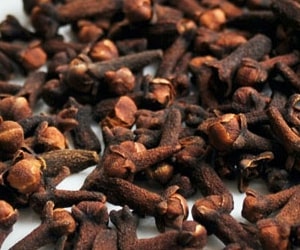
Clove (Syzygium aromaticum) is a spice derived from the flower buds of the clove tree, an evergreen tree native to Indonesia. Cloves are known for their strong, sweet, and aromatic flavor. Here are some key points about cloves:
Flavor Profile:
- Taste: Cloves have a warm, sweet, and slightly bitter taste.
- Aroma: They have a strong and aromatic fragrance.
Culinary Uses:
- Baking: Cloves are commonly used in baking, especially in spice blends and desserts like gingerbread and fruitcakes.
- Spice Blends: They are a key component in various spice blends, including pumpkin spice and garam masala.
- Sauces and Stews: Cloves can be used to add depth to sauces, stews, and marinades for meats.
- Hot Beverages: Cloves are often used in hot beverages like mulled wine, chai tea, and spiced cider.
- Pickling: They are used in pickling spices for fruits and vegetables.
Appearance:
- Form: Cloves are small, dark brown, and nail-shaped.
Health Benefits:
- Antioxidant Properties: Cloves contain compounds with antioxidant properties.
- Anti-Inflammatory Effects: Some studies suggest that cloves may have anti-inflammatory effects.
Medicinal Uses:
- Cloves have been used in traditional medicine for their potential analgesic and antiseptic properties. Clove oil is sometimes used for dental issues due to its numbing effect.
Storage:
- Store whole cloves in a cool, dark place in an airtight container to maintain their flavor.
- Ground cloves have a shorter shelf life, so it’s often recommended to grind them just before use.
- Type – Whole or ground spice.
- Characteristics – Dried flower bud of the tropical clove tree, pungent, sweet in flavor. A native of Indonesia.
- Used in – Marinades, stocks, sauces, braised meats, ham, pastries, fruits, cakes, pickling etc.
Cloves are a versatile spice that adds warmth and depth to both sweet and savory dishes. They are a common ingredient in various cuisines around the world and are valued not only for their flavor but also for their potential health benefits.
16. Coriander
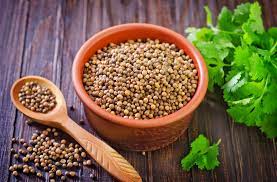
Coriander refers to both an herb (Coriandrum sativum) and the spice made from its seeds. Here are some key points about coriander:
Coriander Herb:
- Leaves: The fresh leaves of the coriander plant are commonly known as cilantro. Cilantro has a fresh, citrusy flavor and is used as a herb in many cuisines, especially in Latin American, Indian, Middle Eastern, and Southeast Asian dishes.
- Culinary Uses: Cilantro leaves are often used to garnish salads, soups, curries, and various other dishes. The leaves add a bright and aromatic quality to the food.
Coriander Seeds (Spice):
- Flavor Profile: Coriander seeds have a warm, citrusy, and slightly sweet flavor. The taste of the seeds is distinct from the fresh cilantro leaves.
- Culinary Uses:
- Ground coriander is a common spice used in various spice blends, including curry powder and garam masala.
- Whole coriander seeds are used in pickling, brining, and as an ingredient in spice-infused liquids.
- Cooking: Coriander seeds are often used in both sweet and savory dishes. They are a key spice in many cuisines, including Indian, Middle Eastern, and Mediterranean.
Appearance:
- Leaves: Cilantro leaves are small and finely divided, resembling flat-leaf parsley.
- Seeds: Coriander seeds are round and have a yellowish-brown color.
Health Benefits:
- Digestive Health: Coriander is believed to have digestive benefits and is sometimes used in traditional medicine for its potential anti-inflammatory properties.
- Antioxidants: The seeds contain antioxidants that contribute to their potential health benefits.
Storage:
- Store both cilantro leaves and coriander seeds in the refrigerator for fresh cilantro and a cool, dark place for coriander seeds.
Coriander is a versatile herb and spice that adds a unique and complex flavor to a wide range of dishes. Whether used fresh or in its seed form, coriander is a popular and integral ingredient in many global cuisines.
- Type – Whole or ground spice.
- Characteristics – Seed of cilantro leaf. Round, light brown seed. Slight aromatic flavor. Native to Argentina and Morocco.
- Used in – Pickling, sausage, stock, pork, curries, gingerbread, salsa, dressing, etc.
17. Cumin
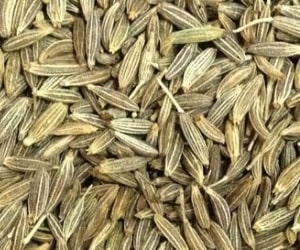
Cumin (Cuminum cyminum) is a spice that comes from the seeds of the cumin plant, a member of the parsley family. Cumin is widely used in various cuisines for its warm, earthy, and slightly citrusy flavor. Here are some key points about cumin:
Flavor Profile:
- Taste: Cumin has a warm, aromatic, and slightly nutty flavor.
- Aroma: It has a distinctive and strong aroma.
Culinary Uses:
- Spice Blends: Cumin is a key ingredient in many spice blends, including curry powder, garam masala, and taco seasoning.
- Mexican Cuisine: It is a staple in Mexican and Tex-Mex dishes such as chili, tacos, and enchiladas.
- Indian Cuisine: Cumin is extensively used in Indian cuisine, particularly in curries, dal, and spice blends like masalas.
- Middle Eastern Cuisine: Cumin is a common spice in Middle Eastern dishes, including falafel, hummus, and various meat dishes.
- Rice and Grains: It is often used to flavor rice, couscous, and other grains.
Appearance:
- Seeds: Cumin seeds are small, elongated, and ridged with a brownish color.
Health Benefits:
- Digestive Health: Cumin is believed to aid in digestion and has been used traditionally for its potential digestive benefits.
- Antioxidant Properties: Cumin contains antioxidants that contribute to its potential health benefits.
Storage:
- Store cumin seeds or ground cumin in a cool, dark place in an airtight container to preserve their flavor.
Cumin is a versatile spice that adds depth and richness to a wide variety of dishes. Its warm and earthy flavor makes it a popular choice in many culinary traditions around the world. Whether used in spice blends, meat dishes, or vegetarian recipes, cumin is valued for its ability to enhance the overall flavor profile of a dish.
- Type – Whole or ground spice.
- Characteristics – Small seed resembling caraway, but lighter in color. Grown in Mexico.
- Used in – Ingredient in chilli and curry powder blends. Sausage, meats, salsa, egg & cheese dishes.
18. Curry Powder

Curry powder is a spice blend that typically combines a variety of ground spices, providing a complex and flavorful profile. While the exact composition can vary, common ingredients include coriander, cumin, turmeric, ginger, and other spices such as cinnamon, cardamom, and cloves. Here are some key points about curry powder:
Flavor Profile:
- Complexity: Curry powder imparts a rich, savory, and aromatic flavor to dishes.
- Versatility: It is a versatile spice blend that can be used in a variety of cuisines beyond South Asian, including Caribbean, Japanese, and British.
Common Ingredients:
- Coriander: Adds citrusy and slightly sweet notes.
- Cumin: Provides earthiness and warmth.
- Turmeric: Imparts a vibrant yellow color and a slightly bitter, peppery flavor.
- Ginger: Adds a warm and pungent kick.
- Cinnamon, Cardamom, Cloves: Contribute to the overall depth and complexity of flavor.
Culinary Uses:
- Curry Dishes: The primary use of curry powder is, of course, in the preparation of curry dishes. It can be used in both vegetarian and non-vegetarian curries.
- Rice and Grains: Sprinkle curry powder over rice, quinoa, or couscous for added flavor.
- Soups and Stews: Enhance the flavor of soups, stews, and sauces with a dash of curry powder.
- Marinades and Rubs: Use curry powder in marinades for meats or as a dry rub for grilling.
- Vegetables: Roast or sauté vegetables with a sprinkle of curry powder for a flavorful side dish.
Homemade vs. Store-Bought:
- Homemade: Making your own curry powder allows you to control the ingredients and customize the blend to your taste preferences.
- Store-Bought: Pre-packaged curry powder is convenient and can be a good option, especially for those who may not have a wide variety of spices on hand.
Spice Level:
- Mild to Hot: The spiciness of curry powder can vary. Some blends are mild, while others can be quite spicy. Check the spice level indicated on store-bought packages or adjust homemade blends accordingly.
Curry powder is a popular and widely used spice blend that adds depth and complexity to a variety of dishes. Its versatility makes it a staple in many kitchens around the world, providing a quick and easy way to infuse rich flavors into a wide range of culinary creations.
- Type – Ground blend, spice.
- Characteristics – Mixture of approx. 20 or more spices, peppery, and yellow, including turmeric, cumin, coriander, ginger, clove, cinnamon, etc. Spiciness can vary from mild to very hot.
- Used in – Curry dishes, vegetables, soups, sauces, meat, fish dishes etc.
19. Dill
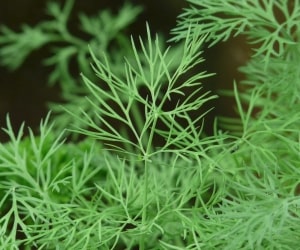
Dill (Anethum graveolens) is an aromatic herb with feathery green leaves and slender stems. Both the leaves (known as dill weed) and the seeds are used in cooking. Dill has a distinctive flavor, often described as fresh, slightly sweet, and with a hint of anise. Here are some key points about dill:
Dill (Fresh Leaves):
- Culinary Uses:
- Dill is a common herb used in the cuisines of Scandinavia, Eastern Europe, and the Mediterranean.
- It is a key ingredient in dishes like pickles, salads, sauces, and fish dishes.
- Dill is often used as a garnish, adding a burst of flavor and a decorative touch.
- Flavor Profile: Dill weed has a bright, grassy flavor with a mild anise undertone.
- Pairs Well With: Fish, seafood, yogurt-based sauces, cucumbers, potatoes, eggs, and salads.
Dill Seeds:
- Culinary Uses:
- Dill seeds are commonly used in pickling, particularly for cucumbers (dill pickles).
- They are also used in spice blends, bread, and certain vegetable dishes.
- Flavor Profile: Dill seeds have a stronger flavor than the fresh leaves, with more pronounced anise notes.
- Pairs Well With: Pickled vegetables, bread, stews, and certain types of savory snacks.
Appearance:
- Dill Leaves: Feathery and fern-like, the leaves are bright green and delicate.
- Dill Seeds: Small, oval-shaped seeds that are light brown in color.
Health Benefits:
- Dill is a good source of vitamins, minerals, and antioxidants.
Culinary Substitutes:
- In recipes that call for dill weed, you can sometimes use fresh tarragon or fennel fronds as substitutes.
Storage:
- Dill: Store fresh dill weed in the refrigerator. Place it in a damp paper towel and seal it in a plastic bag or store it upright in a container with water.
- Dill Seeds: Keep dill seeds in a cool, dark place in an airtight container.
Dill is a versatile herb that adds a distinctive and fresh flavor to various dishes. Whether used as a garnish, in pickling, or as part of spice blends, dill brings a unique taste to the culinary world.
- Type – Whole seed, leaf either fresh or dried.
- Characteristics – Herb and seed with dill pickle flavor. The seed is more pungent than the herb/leaf.
- Used in – Seed is used for pickling, soups, marinades, etc. Herb is used in salads, soups, fish & shellfish, vegetables, sauces, vinegar etc.
20. Fennel
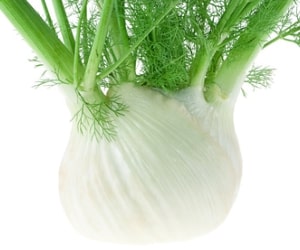
Fennel (Foeniculum vulgare) is a flavorful herb and vegetable with a mild, sweet, licorice-like taste. Both the bulb and the feathery fronds of the plant are edible, and they are used in various culinary applications. Here are some key points about fennel:
Bulb:
- Culinary Uses:
- The bulb is crunchy and has a slightly sweet taste with a subtle anise flavor.
- It is used in salads, slaws, and as a raw or cooked vegetable in various dishes.
- Cooking Methods:
- Fennel can be sliced or chopped and used in both raw and cooked preparations.
- It can be roasted, sautéed, grilled, or braised to bring out its sweetness.
- Pairs Well With:
- Fennel pairs well with citrus fruits, seafood, pork, and in Mediterranean and Italian cuisines.
Fronds (Leaves):
- Culinary Uses:
- The feathery fronds are often used as an herb to garnish dishes or to flavor salads and soups.
- Flavor Profile:
- The fronds have a milder flavor than the seeds and add a fresh, herbal element to dishes.
Seeds:
- Culinary Uses:
- Fennel seeds are used as a spice in cooking, particularly in Indian, Middle Eastern, and Mediterranean cuisines.
- They have a more intense licorice flavor compared to the bulb or fronds.
- Spice Blends:
- Fennel seeds are often included in spice blends, sausage making, and certain types of bread.
Appearance:
- Bulb: The bulb is bulbous at the base with tightly packed, overlapping layers.
- Fronds: The feathery fronds resemble dill but have a distinct flavor.
- Seeds: Small, oblong seeds that are greenish-brown in color.
Health Benefits:
- Fennel is a good source of fiber, vitamin C, and various minerals.
- It is sometimes used in herbal medicine for its potential digestive and anti-inflammatory properties.
Culinary Substitutes:
- If fennel is not available, celery or celery root can be used as a substitute in some recipes.
Storage:
- Store fennel bulbs in the refrigerator, and use them within a few days for the best flavor.
- Fennel seeds can be stored in a cool, dark place in an airtight container.
Fennel adds a unique and refreshing flavor to a variety of dishes, and its different parts can be used in both savory and sweet preparations. Whether enjoyed raw, cooked, or as a spice, fennel is a versatile ingredient that enhances the overall taste of many recipes.
- Type – Whole seed.
- Characteristics – Greenish brown seed, similar in flavor to Anise. Mostly grown in America, Asia, and Africa.
- Used in – Sausages, Curry, tomato, sauces, marinades, fish, pickling etc.
21. Fine Herbs
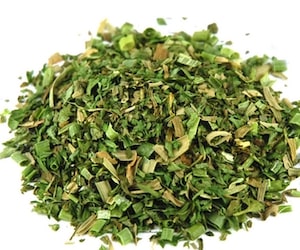
“Fines herbes” (pronounced feen erb) is a term used in French cuisine to refer to a specific mixture of delicate fresh herbs. This classic herb blend is often used to enhance the flavors of various dishes, particularly in French cooking. The traditional fines herbes mixture typically includes four specific herbs in equal proportions. Here are the key components of fines herbes:
- Chervil (Anthriscus cerefolium):
- Flavor: Chervil has a delicate, slightly sweet, and anise-like flavor.
- Appearance: It has finely divided, feathery leaves and is often used as a garnish.
- Parsley (Petroselinum crispum):
- Flavor: Parsley adds a fresh, mildly peppery taste.
- Appearance: It has flat or curly leaves and is widely used in various cuisines.
- Tarragon (Artemisia dracunculus):
- Flavor: Tarragon contributes a distinct, mildly licorice-like flavor.
- Appearance: Tarragon has slender, pointed leaves and is a key herb in French cuisine.
- Chives (Allium schoenoprasum):
- Flavor: Chives provide a mild onion or garlic flavor.
- Appearance: Chives have long, thin, hollow stems and are often used as a garnish.
Culinary Uses:
- Seasoning: Fines herbes are often used to season and garnish dishes, especially those with delicate flavors, such as eggs, salads, and seafood.
- Herb Butter: Fines herbes are commonly used in the preparation of herb-infused butter.
- French Cuisine: They are a classic component in French dishes, contributing to the finesse and subtlety of flavors.
Culinary Substitutes:
- If fines herbes are not available, a simple mix of chervil, parsley, and chives can still add a similar fresh and herby touch to dishes.
Storage:
- Fresh fines herbes should be stored in the refrigerator. Wrap them in a damp paper towel and place them in a plastic bag to maintain freshness.
Fines herbes add a nuanced and elegant flavor to dishes, and their combination is designed to complement rather than overpower the main ingredients. This classic herb blend is a staple in French culinary traditions and has influenced the preparation of many dishes around the world.
- Type – Herb Blend.
- Characteristics – Generally a bouquet blend of three or more herbs is used to enhance various dishes. Finely chopped herb mixture of chives, tarragon, parsley, basil, savory, etc.
- Used in – Herb sauce, compound butter, broiled meats, fish, etc.
22. Juniper Berry
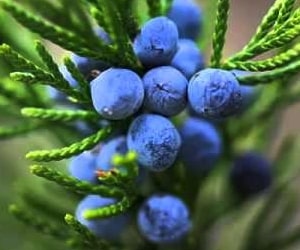
Juniper berries are the small, aromatic cones produced by juniper trees (Juniperus spp.). These berries are not true berries but rather seed cones with fleshy and merged scales, giving them a berry-like appearance. Juniper berries are known for their distinctive flavor and are used in various culinary and beverage applications. Here are some key points about juniper berries:
Flavor Profile:
- Taste: Juniper berries have a unique, piney, and slightly citrusy flavor.
- Aroma: They have a strong, aromatic fragrance.
Culinary Uses:
- Flavoring Agent: Juniper berries are often used as a spice to flavor various dishes, especially in European cuisines. They can impart a subtle earthy and resinous taste.
- Meats: Juniper berries are a classic ingredient in the preparation of certain meats, particularly game meats like venison, as well as in sauerkraut dishes.
- Pickling: They are used in pickling spices for items like pickles and certain cured meats.
- Alcoholic Beverages: Juniper berries are a key botanical in the production of gin, contributing to its characteristic flavor.
Appearance:
- Color: The berries are typically dark purple or blue, and their color may change as they mature.
- Size: They are small, roughly pea-sized.
Health Considerations:
- Juniper berries have been used traditionally in herbal medicine for their potential diuretic and digestive properties.
- It’s important to note that excessive consumption of juniper berries or juniper-containing products may not be suitable for certain individuals, especially those with kidney issues or during pregnancy. It’s advisable to consult with a healthcare professional before using them for medicinal purposes.
Storage:
- Store juniper berries in a cool, dark place in an airtight container to preserve their flavor.
- Type – Whole Spice.
- Characteristics – Slightly soft, purple burry, piney flavor. It’s used as the principal flavor of Gin.
- Used in – Marinades, game dishes, sauerkraut.
Juniper berries contribute a unique and memorable flavor to various culinary creations, especially in the context of meat dishes and certain beverages. Whether used in traditional European recipes or modern gastronomy, juniper berries are valued for their ability to add complexity and depth to the flavors of the dishes they enhance.
23. Mace
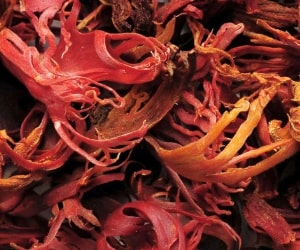
Mace is a spice that comes from the aril (the outer covering) of the nutmeg seed (Myristica fragrans), an evergreen tree native to the Moluccas, or Spice Islands, in Indonesia. Mace has a distinct flavor and aroma and is used in both sweet and savory dishes. Here are some key points about mace:
Flavor Profile:
- Taste: Mace has a warm, sweet, and slightly peppery flavor.
- Aroma: It has a fragrant and aromatic quality.
Culinary Uses:
- Baking: Mace is used in baking, particularly in sweet dishes like cakes, cookies, and pastries. It pairs well with fruits, custards, and creamy desserts.
- Savory Dishes: Mace is used in certain savory dishes, including soups, stews, sauces, and meat-based preparations. It is a common ingredient in spice blends for meats.
- Indian Cuisine: Mace is a component of some Indian spice blends, such as garam masala.
Appearance:
- Form: Mace is sold in the form of dried, reddish-brown, ribbon-like blades. Each blade is the aril that surrounds the nutmeg seed.
Substitutes:
- Mace has a flavor similar to nutmeg, albeit milder. If mace is not available, nutmeg can be used as a substitute, though the quantity may need adjustment due to differences in potency.
Storage:
- Store mace blades in a cool, dark place in an airtight container to preserve their flavor.
Health Considerations:
- Mace, like nutmeg, contains compounds that have been traditionally associated with various health benefits, but it should be used in moderation as excessive consumption may lead to adverse effects.
Mace is a versatile spice that adds warmth and depth to a variety of dishes. Its slightly sweeter and milder flavor compared to nutmeg makes it suitable for both sweet and savory culinary applications. Whether used in traditional recipes or contemporary cuisine, mace is valued for its ability to enhance the overall flavor profile of a dish.
- Type – Whole blade or ground spice.
- Characteristics – Made from the outer covering of nutmeg. Orange-red in color. Aromatic, similar to nutmeg in flavor but milder.
- Used in – Baked goods, desserts, fruits, Indian curry dishes, sausage, fish, vegetables, salads and sauces.
24. Marjoram
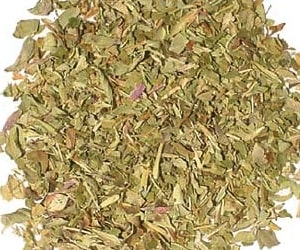
Marjoram (Origanum majorana) is an aromatic herb in the mint family (Lamiaceae) that is commonly used in culinary applications. It is closely related to oregano but has a milder and sweeter flavor. Here are some key points about marjoram:
Flavor Profile:
- Taste: Marjoram has a delicate, sweet, and slightly floral flavor.
- Aroma: It has a pleasant and mild aromatic fragrance.
Culinary Uses:
- Seasoning: Marjoram is often used to season a variety of dishes, including soups, stews, sauces, and dressings.
- Meats: It pairs well with meats, particularly lamb, veal, and poultry. It is a common ingredient in sausage making.
- Vegetables: Marjoram can enhance the flavor of roasted or grilled vegetables.
- Italian Cuisine: It is a key herb in Mediterranean and Italian cuisines, often used in tomato-based sauces, pasta dishes, and pizzas.
Appearance:
- Leaves: Marjoram has small, oval-shaped leaves that are green and fragrant.
Health Benefits:
- Marjoram has been traditionally used in herbal medicine for its potential digestive and mild sedative properties.
Culinary Substitutes:
- If marjoram is unavailable, oregano is a suitable substitute, though it has a stronger flavor. Alternatively, thyme or basil can be used as milder substitutes.
Storage:
- Fresh marjoram can be stored in the refrigerator, wrapped in a damp paper towel and placed in a plastic bag.
- Dried marjoram should be stored in a cool, dark place in an airtight container.
Marjoram is a versatile herb that adds a gentle and aromatic touch to a variety of dishes. Its mild flavor makes it a popular choice for enhancing the overall taste of both savory and some sweet recipes. Whether used fresh or dried, marjoram is valued for its ability to complement and balance the flavors in a range of culinary creations.
- Type – Dried herb leaf.
- Characteristics – Grey-green herb from the mint family. Similar to oregano but milder.
- Used in – Beef, beal, lamb, sausage, pates, poultry, stews, soups, vegetables, salads, and sauces.
25. Mint
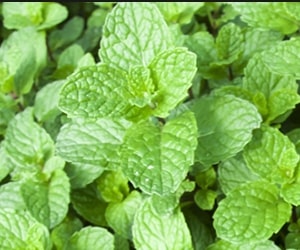
Mint leaves, derived from the Mentha genus of plants, are known for their refreshing flavor and aromatic qualities. Common varieties include peppermint, spearmint, and others. Here are some key points about mint leaves:
Culinary Uses:
- Teas: Mint leaves are widely used to make herbal teas. Peppermint and spearmint teas are popular choices for their refreshing taste.
- Desserts: Mint leaves are used to flavor a variety of desserts, including ice cream, chocolates, and baked goods. They can also be used as a garnish.
- Salads: Mint leaves add freshness to salads, fruit salads, and grain salads.
- Beverages: Mint leaves are often used as a garnish in beverages, including lemonades, iced teas, and cocktails.
- Sauces and Chutneys: Mint leaves are used to make mint sauces, chutneys, and dressings, especially in Middle Eastern and Indian cuisines.
Appearance:
- Leaves: Mint leaves are typically small, green, and serrated. The appearance can vary depending on the mint variety.
Health Benefits:
- Digestive Health: Mint is known for its potential to soothe indigestion and relieve symptoms of irritable bowel syndrome (IBS).
- Breath Freshener: The menthol in mint leaves provides a cooling sensation and is often used to freshen breath.
Culinary Substitutes:
- Different varieties of mint can often be used interchangeably, but they may have subtle flavor differences.
Storage:
- Fresh Mint Leaves: Store fresh mint leaves in the refrigerator. To extend freshness, trim the stems, place in water, and cover with a plastic bag.
- Dried Mint Leaves: Store dried mint leaves in a cool, dark place in an airtight container.
Mint leaves are versatile and widely used in various culinary applications to add a burst of flavor and freshness. Whether enjoyed in teas, desserts, salads, or savory dishes, mint leaves contribute a distinctive and pleasant element to a range of recipes.
- Type – Herb leaf used as fresh or dried.
- Characteristics – Aromatic herb with cool flavor. Spearmint and peppermint are most common.
- Used in – Lamb, fruits, tea, desserts, tea, fruit, beverages, peas, carrots, potatoes, soups, sauces, etc.
26. MirepoixMirepoix (meer-pwah) - Mixture of vegetables; herbs; and spices used to enhance the flavour of meat;...
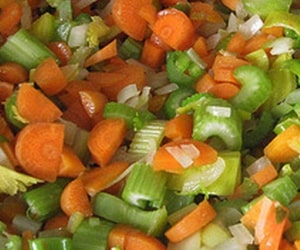
Mirepoix is a classic aromatic vegetable mixture used as a base for many dishes in French cuisine. It serves as a flavor foundation for stocks, soups, stews, and sauces. The traditional mirepoix consists of three main ingredients: onions, carrots, and celery. The ratios of these vegetables can vary, but a common ratio is two parts onion, one part carrot, and one part celery.
Components of Mirepoix:
- Onions:
- Flavor Profile: Onions contribute a sweet and savory flavor to the mixture.
- Type: Yellow onions are often used, but white or red onions can also be suitable.
- Carrots:
- Flavor Profile: Carrots add sweetness and a subtle earthy flavor.
- Preparation: Carrots are typically peeled and diced or sliced.
- Celery:
- Flavor Profile: Celery provides a mild, herbal, and slightly peppery taste.
- Preparation: Celery is usually washed and chopped into small pieces.
Culinary Uses:
- Stocks and Broths: Mirepoix serves as the aromatic base for making stocks and broths. It infuses the liquid with its flavors during the long cooking process.
- Soups and Stews: Many soups and stews begin with a mirepoix to build a flavorful foundation for the dish.
- Sauces: Mirepoix is often used in the preparation of sauces, such as tomato sauce and demi-glace.
Variations:
- White Mirepoix: In some recipes, especially those requiring a lighter color, leeks are used instead of onions to create a “white mirepoix.”
- Browned Mirepoix: In certain dishes, the mirepoix may be sautéed until browned before adding other ingredients, enhancing the depth of flavor.
Usage Tips:
- Mirepoix is typically used in the early stages of cooking. The vegetables are often sautéed in oil or butter to release their flavors before adding other ingredients.
- The size of the vegetable pieces can vary based on the recipe. Finely diced mirepoix is common for stocks, while larger chunks may be suitable for heartier dishes.
Mirepoix is a fundamental element in classical French cooking, providing a flavorful base for a wide range of dishes. Its aromatic combination of onions, carrots, and celery forms the backbone of numerous culinary preparations, adding depth and complexity to the overall taste of the final dishes.
- Type – Flavoring Mix.
- Characteristics – Mixture of vegetables, herbs, and spices used to enhance the flavor of meat, fish, and shellfish dishes. Common ingredients are onion, celery, carrot leek, garlic, peppercorns, bay leaf, clove, thyme and rosemary.
- Used in – Stocks, soups, sauces, roasts, etc.
27. MustardThe three main kinds are English - strong; French -milder; and German - spiced with herbs. also coar... Seed
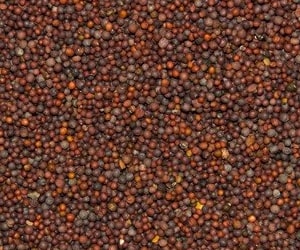
Mustard seeds are the small seeds of the mustard plant (Brassica spp.), which is a member of the cabbage family. These seeds come in different colors, including yellow, brown, and black, each with its own unique flavor profile. Mustard seeds are a versatile spice used in various culinary applications around the world. Here are some key points about mustard seeds:
Types of Mustard Seeds:
- Yellow Mustard Seeds:
- Flavor Profile: Mild and slightly tangy.
- Common Uses: Yellow mustard seeds are used to make the classic yellow mustard commonly found on hot dogs and sandwiches.
- Brown Mustard Seeds:
- Flavor Profile: More pungent and slightly bitter than yellow mustard seeds.
- Common Uses: Brown mustard seeds are often used in European and Asian cuisines. They are a key ingredient in Dijon mustard.
- Black Mustard Seeds:
- Flavor Profile: The most pungent and peppery among the three.
- Common Uses: Black mustard seeds are frequently used in Indian cooking, adding heat and depth to various dishes.
Culinary Uses:
- Condiments: Mustard seeds are a key ingredient in mustard condiments, ranging from mild yellow mustard to spicy Dijon mustard.
- Pickling: Mustard seeds are used in pickling spice blends for vegetables, fruits, and meats.
- Curries and Spice Blends: In Indian cuisine, especially in South Indian dishes, mustard seeds are often tempered in hot oil to release their flavor before adding other ingredients.
- Marinades and Rubs: Mustard seeds can be ground and used in marinades for meats and as a component of spice rubs.
- Breads and Baked Goods: Mustard seeds are sometimes added to bread dough or used as a topping for pretzels and crackers.
Appearance:
- Color: Yellow mustard seeds are pale yellow, brown mustard seeds are various shades of brown, and black mustard seeds are black or dark brown.
- Size: Mustard seeds are small, round, and typically about 1-2 millimeters in diameter.
Health Benefits:
- Mustard seeds contain various nutrients, including selenium, omega-3 fatty acids, and fiber.
- Some studies suggest that mustard seeds may have potential health benefits, such as anti-inflammatory and antioxidant properties.
Storage:
- Store mustard seeds in a cool, dark place in an airtight container to maintain their flavor.
Mustard seeds contribute distinct flavors and heat levels to a wide range of dishes, making them a popular and versatile spice in many cuisines. The choice of mustard seed variety can significantly impact the overall taste of the final dish.
- Type – Whole or ground seed.
- Characteristics – Very pungent seed, seen in white, yellow, or brown.
- Used in – Blended with vinegar to prepare the mustard sauce. Pickling, sauces, curries, salsa. Mustard sauce is used for salad dressing, sandwiches, ham, sauces etc.
28. Nasturtium
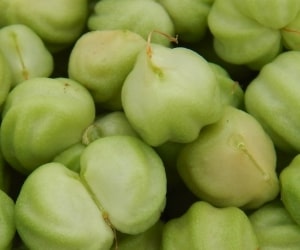
Nasturtium (Tropaeolum majus) refers to a genus of flowering plants that includes both annual and perennial varieties. The common garden nasturtium, Tropaeolum majus, is widely known for its vibrant flowers and distinctive leaves. Here are some key points about nasturtium:
Appearance:
- Flowers:
- Nasturtium flowers come in various colors, including shades of orange, yellow, and red.
- The flowers are often spurred and have a unique shape resembling miniature water lilies.
- Leaves:
- Nasturtium leaves are round and shield-shaped, with a peppery taste similar to watercress.
- Growth Habit:
- Nasturtium plants can trail or climb, making them suitable for hanging baskets, containers, or as ground cover.
Culinary Uses:
- Edible Flowers:
- Nasturtium flowers are edible and are often used to garnish salads, desserts, and other dishes.
- They have a mildly peppery and slightly sweet flavor.
- Leaves:
- Nasturtium leaves are also edible and add a peppery kick to salads or can be used in pesto.
- Seeds:
- Nasturtium seeds can be pickled and used as a substitute for capers.
Health Benefits:
- Nasturtium leaves and flowers are rich in vitamin C and contain compounds that may have potential antioxidant and antimicrobial properties.
Companion Planting:
- Nasturtiums are often used in companion planting to deter certain pests in vegetable gardens. They can attract aphids away from more vulnerable plants.
Growing Nasturtium:
- Soil: Nasturtiums prefer well-drained soil and can tolerate poor soil conditions.
- Sunlight: They thrive in full sun but can tolerate partial shade.
- Watering: Nasturtiums are relatively drought-tolerant but benefit from regular watering.
- Propagation: Nasturtiums can be grown from seeds, which are large and easy to handle.
Caution:
- While nasturtium flowers and leaves are generally safe to eat, it’s essential to ensure they are grown in uncontaminated soil without pesticides.
Nasturtiums not only add color to gardens but also provide an edible and peppery addition to culinary creations. Their versatility in both ornamental and culinary use makes them popular choices for gardeners and chefs alike.
- Type – Leaf and seed.
- Characteristics – Plant with yellow, orange, and red flowers with sharp casting leaves and seeds with a pungent odour.
- Used in – Salads, and pickling mustard.
29. Nutmeg
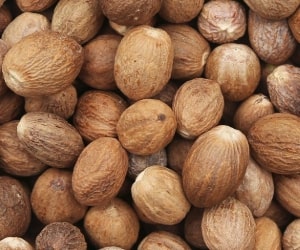
Nutmeg (Myristica fragrans) is a spice derived from the seed of the nutmeg tree, which is native to the Banda Islands in Indonesia. The spice is known for its warm, sweet, and nutty flavor, and it is often used in both sweet and savory dishes. Nutmeg is also unique in that it has two forms: the whole seed, commonly referred to as nutmeg, and the ground seed, known as ground nutmeg. Here are some key points about nutmeg:
Culinary Uses:
- Baking: Nutmeg is a popular spice in baking, adding depth of flavor to cakes, cookies, pies, and pastries.
- Desserts: It is commonly used in creamy desserts like custards, puddings, and ice creams.
- Savory Dishes: Nutmeg is used in various savory dishes, including soups, stews, sauces, and certain meat and vegetable preparations.
- Beverages: It is a key ingredient in some warm beverages like eggnog and mulled wine.
Appearance:
- Whole Nutmeg: The whole nutmeg seed is about the size of a small plum pit and has a hard, brown outer shell.
- Ground Nutmeg: The ground form is a fine powder with a rich, brown color.
Flavor Profile:
- Nutmeg has a warm, sweet, and slightly nutty flavor with hints of clove and a touch of spiciness.
Culinary Substitutes:
- Ground nutmeg can be used as a substitute for whole nutmeg, but the flavor may differ slightly.
Health Considerations:
- Nutmeg contains a compound called myristicin, and consuming very large amounts may lead to potential toxic effects. However, normal culinary use is generally considered safe.
Storage:
- Whole nutmeg seeds and ground nutmeg should be stored in a cool, dark place in airtight containers to preserve their flavor.
Nutmeg Grater:
- Some recipes call for freshly grated nutmeg for optimal flavor. Nutmeg graters are small, specialized tools designed for this purpose.
Nutmeg is a versatile spice that can enhance the flavor of both sweet and savory dishes. Whether used in baking, cooking, or as a finishing touch, nutmeg adds a warm and aromatic element to a variety of culinary creations.
- Type – Whole or ground powder.
- Characteristics – Sweet, aromatic, the kernel of nutmeg fruit. Grown in the Netherlands and India.
- Used in – Baked goods, pies, cream, sauces, soups, chicken, veal, vegetable dishes, desserts and bread.
30. Oregano
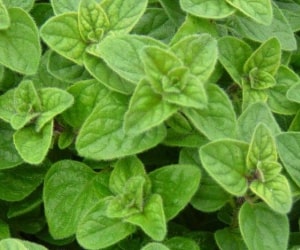
Oregano (Origanum vulgare) is a fragrant herb that belongs to the mint family (Lamiaceae). It is native to the Mediterranean region but is now cultivated worldwide. Oregano is known for its robust and savory flavor, which is commonly used in Mediterranean, Italian, and Mexican cuisines. Here are some key points about oregano:
Culinary Uses:
- Italian Cuisine: Oregano is a staple herb in Italian dishes, including pizzas, pasta sauces, and Mediterranean salads.
- Mexican Cuisine: It is often used in Mexican dishes, such as tacos, salsas, and enchiladas.
- Grilled Meats: Oregano complements the flavors of grilled meats, including lamb, chicken, and beef.
- Vegetables: It pairs well with roasted or grilled vegetables, bringing a savory and earthy flavor.
Varieties:
- Common Oregano (Origanum vulgare): Also known as wild marjoram, this is the variety most commonly used in culinary applications.
- Mexican Oregano (Lippia graveolens): Despite the name, it is not botanically related to common oregano. It has a citrusy flavor and is often used in Mexican and Latin American cuisines.
Appearance:
- Leaves: Oregano has small, oval-shaped leaves that are green and aromatic.
Flavor Profile:
- Oregano has a robust, slightly peppery, and earthy flavor with hints of citrus.
Culinary Substitutes:
- If fresh oregano is not available, dried oregano can be used, but adjustments to the quantity may be needed as dried herbs are more concentrated.
Health Benefits:
- Oregano contains compounds that are believed to have antioxidant, anti-inflammatory, and antimicrobial properties.
Storage:
- Fresh oregano can be stored in the refrigerator, wrapped in a damp paper towel and placed in a plastic bag.
- Dried oregano should be kept in a cool, dark place in an airtight container.
Oregano is a versatile herb that adds depth and richness to a variety of dishes. Whether used fresh or dried, it is valued for its ability to enhance the overall flavor profile of both savory and herbaceous recipes.
- Type – Leaf or ground herb either fresh or dried.
- Characteristics – Pungent herb, similar to marjoram, but stronger. Native to Italy and Mexico, grown domestically.
- Used in – Italian and Mexican dishes, tomato sauces, soups, sauces, pizza, stews, meats, pasta etc.
31. Paprika

Paprika is a spice made from ground, dried red peppers. The specific type of pepper used and the method of preparation can influence the flavor, color, and heat level of paprika. It is widely used in various cuisines to add color and flavor to dishes. Here are some key points about paprika:
Varieties:
- Sweet (mild) Paprika:
- Flavor Profile: Mild and slightly sweet with vibrant red color.
- Common Uses: Used for color and flavor in dishes like stews, rice dishes, and as a garnish.
- Hot (spicy) Paprika:
- Flavor Profile: Spicier than sweet paprika with a moderate heat level.
- Common Uses: Adds heat and color to dishes like goulash, soups, and spicy sauces.
- Smoked Paprika (Pimentón):
- Flavor Profile: Smoky and rich, with varying levels of heat.
- Common Uses: Frequently used in Spanish and Mexican cuisines, adds a smoky flavor to dishes like paella, chorizo, and barbecue rubs.
Culinary Uses:
- Seasoning and Garnish:
- Paprika is often used as a seasoning and garnish for a variety of dishes, including meats, vegetables, and dips.
- Colorant:
- It adds vibrant red color to dishes without adding significant heat.
- Spice Blends:
- Paprika is a common ingredient in spice blends, such as curry powder and various rubs.
- Deviled Eggs:
- It is a classic ingredient in deviled egg recipes, providing both color and flavor.
Appearance:
- Color: Paprika comes in various colors, including bright red, deep red, or even brown, depending on the variety.
- Texture: It is usually ground into a fine powder.
Health Benefits:
- Paprika contains antioxidants, including vitamin C and carotenoids.
- Some studies suggest that capsaicin, the compound responsible for the heat in spicy paprika, may have metabolism-boosting properties.
Storage:
- Store paprika in a cool, dark place in an airtight container to preserve its flavor and color.
Caution:
- Pay attention to the type of paprika specified in recipes, as different varieties can significantly affect the flavor and heat level of a dish.
Paprika is a versatile spice that adds color and flavor to a wide range of dishes. Its distinct varieties cater to different taste preferences, making it a popular choice in various global cuisines.
- Type – Ground Spice.
- Characteristics – Ground from the dried sweet red pepper. Spanish: Bright & Mild. Hungarian: Dark & more pungent.
- Used in – Fish, seafood, meats, salads, sauces, dressings, garnish, etc.
32. Parsley
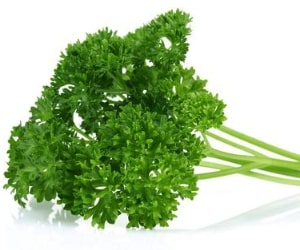
Parsley (Petroselinum crispum) is a versatile herb widely used in culinary applications around the world. It belongs to the Apiaceae family and is known for its fresh and slightly peppery flavor. Parsley is often used as a garnish, but it also plays a significant role in enhancing the flavor of a variety of dishes. Here are some key points about parsley:
Varieties:
- Curly-Leaf Parsley:
- Appearance: Dark green, tightly curled leaves.
- Flavor: Mild and slightly peppery.
- Flat-Leaf Parsley (Italian Parsley):
- Appearance: Dark green, flat, serrated leaves.
- Flavor: Robust and more intense than curly-leaf parsley.
Culinary Uses:
- Garnish:
- Parsley is commonly used as a garnish to add a pop of color and freshness to various dishes.
- Seasoning:
- It is used as a flavor enhancer in a wide range of recipes, including soups, stews, sauces, and salads.
- Herb Blends:
- Parsley is a key ingredient in various herb blends, such as fines herbes and bouquet garni.
- Tabbouleh:
- Flat-leaf parsley is a crucial ingredient in tabbouleh, a Middle Eastern salad.
- Pesto:
- Flat-leaf parsley can be used in combination with other herbs in pesto recipes.
Health Benefits:
- Parsley is a good source of vitamins A, C, and K, as well as folate and iron.
- It contains antioxidants and has been traditionally used for its potential diuretic properties.
Storage:
- Fresh Parsley: Store fresh parsley in the refrigerator. Trim the stems, place in a jar with water, and cover the leaves with a plastic bag for extended freshness.
- Dried Parsley: Store dried parsley in a cool, dark place in an airtight container.
Culinary Substitutes:
- Substitute for Curly Parsley: Flat-leaf parsley can be used as a substitute for curly parsley, but note that the flavor is more robust.
- Substitute for Flat-Leaf Parsley: If flat-leaf parsley is unavailable, cilantro can be used as a substitute in some dishes, although the flavor is different.
Caution:
- While parsley is generally safe when used in culinary amounts, excessive consumption of the concentrated essential oil or supplements should be avoided during pregnancy.
Parsley is an essential herb in many kitchens, valued for its ability to add freshness and flavor to a wide range of dishes. Whether used as a garnish, a seasoning, or a key ingredient in various recipes, parsley is a versatile herb that contributes to the overall taste and visual appeal of culinary creations.
- Type – Fresh leaf herb in bunches. Dried.
- Characteristics – Green leaf, curly or flat, With delicate sweet flavor. Is an excellent source of vitamin C.
- Used in – Garnish, fried, stews, sauces, salads, vegetables, potatoes.
33. Pepper
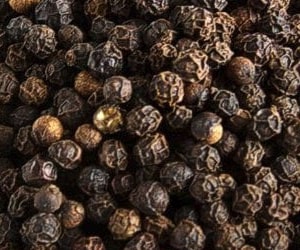
Pepper refers to a variety of spices derived from the fruits of the pepper plant (Piperaceae family). The most common types of pepper include black pepper, white pepper, and green pepper. Each type has its own distinct flavor profile and uses. Here are some key points about pepper:
Types of Pepper:
- Black Pepper (Piper nigrum):
- Flavor Profile: Pungent, warm, and slightly spicy with earthy notes.
- Common Uses: Used in almost every cuisine globally, especially in savory dishes, soups, stews, and as a table condiment.
- White Pepper (Piper nigrum):
- Flavor Profile: Milder and less complex than black pepper with a subtle heat.
- Common Uses: Preferred in dishes where the appearance of black specks is undesirable, such as white sauces, cream-based soups, and light-colored dishes.
- Green Pepper (Unripe Piper nigrum berries):
- Flavor Profile: Fresher, less pungent, and more herbaceous than black or white pepper.
- Common Uses: Used in some culinary applications, often in pickling, brining, or in green peppercorn sauces.
Culinary Uses:
- Seasoning:
- Pepper is a universal seasoning, enhancing the flavor of a wide range of dishes.
- Table Condiment:
- Ground black pepper is a common table condiment.
- Spice Blends:
- It is an essential component of various spice blends, such as mixed peppercorns and seasoned pepper blends.
- Preservation:
- Peppercorns are used in pickling and brining to add flavor and depth.
Health Benefits:
- Pepper contains piperine, a compound that may have potential anti-inflammatory and antioxidant properties.
- Piperine has also been studied for its potential role in improving nutrient absorption.
Storage:
- Store whole peppercorns in a cool, dark place in an airtight container to maintain freshness.
- Ground pepper should be stored in a dark container away from heat and light.
Peppercorn Varieties:
- Tellicherry Peppercorns:
- Grown in the Malabar region of India, these are larger and often considered to have a complex flavor.
- Malabar Peppercorns:
- Also from the Malabar region, these are known for their bold and robust flavor.
- Lampong Peppercorns:
- Grown in Indonesia, these peppercorns are known for their mild heat and citrusy notes.
Caution:
- Excessive consumption of black pepper may cause irritation for some individuals, particularly those with gastrointestinal issues.
Pepper is an indispensable spice in the culinary world, appreciated for its ability to elevate the flavor of a wide variety of dishes. Whether used in its whole form or ground, pepper adds a distinctive and essential element to many cuisines globally.
- Type – Whole as peppercorns / black, white, or green cracked/fine ground or powder.
- Characteristics – Small hard berry. Black Pepper: Pungent, aromatic. White Pepper: Made after removing the black outer covering which is milder. Adds a sharp tang to all foods. Gree: Packed in a mild brine.
- Used in – Widely used in many food dishes.
34. Rosemary
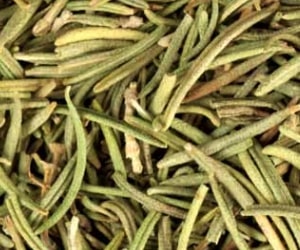
Rosemary (Rosmarinus officinalis) is an aromatic herb with needle-like leaves that belong to the mint family (Lamiaceae). Known for its fragrant and resinous aroma, rosemary is a versatile herb widely used in various culinary and medicinal applications. Here are some key points about rosemary:
Culinary Uses:
- Seasoning:
- Rosemary is a popular herb used to season a variety of dishes, including roasted meats (particularly lamb), poultry, fish, and vegetables.
- Baking:
- It is used in bread, focaccia, and other baked goods to add a distinctive herbal flavor.
- Infusions:
- Rosemary can be used to infuse oils, vinegars, and marinades, adding its aromatic essence to the liquids.
- Herb Blends:
- It is often included in herb blends like herbes de Provence.
Flavor Profile:
- Rosemary has a robust and pine-like flavor with hints of lemon and camphor.
Medicinal Uses:
- Traditional Medicine:
- Rosemary has been used in traditional medicine for its potential health benefits, including anti-inflammatory and antioxidant properties.
- Aromatherapy:
- The essential oil derived from rosemary is used in aromatherapy and has been associated with potential cognitive benefits.
Appearance:
- Leaves: The leaves are needle-like, dark green on top, and silver-gray on the underside.
Growing Rosemary:
- Rosemary is a hardy perennial herb that prefers well-drained soil and plenty of sunlight.
- It can be grown in pots or in the ground and is often used in landscaping due to its attractive and aromatic qualities.
Storage:
- Fresh rosemary can be stored in the refrigerator for a short period. For longer storage, it can be dried or frozen.
- Dried rosemary should be stored in a cool, dark place in an airtight container.
Culinary Substitutes:
- If fresh rosemary is not available, dried rosemary can be used, but use it sparingly, as dried herbs are more concentrated.
Caution:
- Rosemary is generally safe for culinary use, but when using it medicinally or in large quantities, it’s advisable to consult with a healthcare professional.
Rosemary’s distinctive flavor and aroma make it a favorite herb in many kitchens. Whether used to enhance the flavor of savory dishes or as a fragrant addition to oils and infusions, rosemary adds a unique and aromatic element to culinary creations.
- Type – Whole leaf herb, fresh or dried.
- Characteristics – Light green leaves resembling pine needles. Very aromatic. Once grown, very healthy and strong, even in cold weather.
- Used in – Lamb, fish, beef, sauces, soups, stews, salads and marinades.
35. Sachet BagSachet Bag- Herbs and spices tied in a cheesecloth/muslin bag; used for the flavouring of stocks; sa...
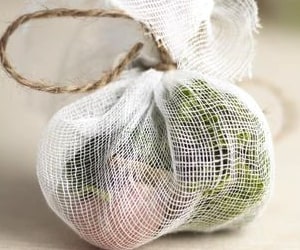
A sachet spice bag typically refers to a small pouch filled with a blend of spices or herbs used for seasoning or infusing flavor in cooking. These spice bags are often used in various culinary applications to enhance the taste of soups, stews, broths, and sauces. Here are some key points about sachet spice bags:
Components of a Sachet Spice Bag:
- Spices and Herbs:
- The primary contents of a sachet spice bag are a combination of whole spices, herbs, or aromatic ingredients chosen to impart specific flavors to the dish.
- Fabric:
- Similar to other sachet bags, the spice bag is typically made from a breathable fabric, allowing the flavors to infuse into the cooking liquid.
- Tie or Seal:
- The bag is often tied or sealed securely to contain the spices and prevent them from dispersing into the dish.
Uses of Sachet Spice Bags:
- Flavor Infusion:
- Sachet spice bags are added to soups, stews, and sauces during cooking to infuse the dish with aromatic flavors.
- Easy Removal:
- Using a sachet bag makes it convenient to add and later remove the spices from the dish, preventing the need to strain the liquid.
- Customizable Blends:
- The contents of the sachet bag can be customized based on the desired flavors for a particular recipe.
Common Contents:
- Whole Spices:
- Common whole spices include peppercorns, cloves, cinnamon sticks, and bay leaves.
- Herbs:
- Fresh or dried herbs such as thyme, rosemary, or parsley are often included.
- Aromatic Ingredients:
- Garlic, ginger, and citrus peels may be added for additional aroma and flavor.
How to Use:
- Preparation:
- CombineCombine: To mix two ingredients thoroughly. the desired spices and herbs for your recipe.
- Fill the Bag:
- Place the chosen spices and herbs into the sachet bag.
- Seal and Add to Cooking:
- Tie or seal the bag securely, and add it to the pot during cooking.
- Remove Before Serving:
- Once the desired flavors have infused into the dish, remove the sachet bag before serving.
Benefits:
- Convenience: Using a sachet spice bag provides a convenient way to add and remove spices without them dispersing throughout the dish.
- Flavor Control: It allows for precise control over the flavor profile of the dish.
- Easy Cleanup: Eliminates the need to strain or pick out individual spices from the finished dish.
Sachet spice bags are a practical and effective method for infusing dishes with aromatic flavors while maintaining convenience and ease of preparation. They offer a flexible and customizable approach to seasoning various recipes.
- Type – Spice Mix.
- Characteristics – Various spices tied in a small cheesecloth sack.
- Used in – Braised meats, game stews, picking, etc.
36. Saffron
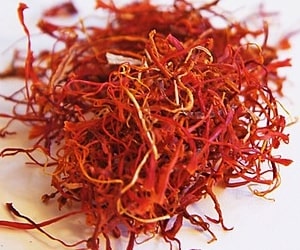
Saffron (Crocus sativus) is a highly prized and aromatic spice derived from the dried stigmas of the saffron crocus flower. Known for its vibrant color, distinct flavor, and unique aroma, saffron is one of the most expensive spices in the world. Here are some key points about saffron:
Key Features:
- Color:
- Saffron imparts a bright golden-yellow to orange-red color to dishes.
- Flavor Profile:
- Saffron has a complex flavor that is floral, slightly sweet, and often described as hay-like or metallic.
- Aroma:
- Saffron has a distinct and fragrant aroma that is released when it is steeped or infused.
Culinary Uses:
- Coloring Agent:
- Saffron is used to add a rich yellow color to a variety of dishes, including rice, paella, and certain desserts.
- Flavoring:
- It imparts its unique flavor to both sweet and savory dishes, such as saffron-infused rice, risottos, and certain breads.
- Beverages:
- Saffron is used to flavor beverages, including teas and infusions.
Saffron Threads:
- Saffron is typically sold in thread form, consisting of the dried stigmas of the crocus flower. These threads are delicate and should be handled with care.
Harvesting and Production:
- Crocus Flower:
- Saffron is derived from the flower Crocus sativus. Each flower produces three red stigmas, which are the saffron threads.
- Hand Harvesting:
- Harvesting saffron is a labor-intensive process as the delicate threads must be hand-picked from each flower.
Quality Grading:
- Saffron quality is often graded based on factors such as color, flavor, and aroma. The highest quality is often labeled as “Category I” or “Grade A.”
Health Benefits:
- Saffron contains compounds like crocin and safranal, which are believed to have antioxidant and anti-inflammatory properties.
- Some studies suggest potential health benefits, including mood enhancement and potential anti-depressant effects, though more research is needed.
Usage Tips:
- Infusion: To release the flavor and color, saffron threads are often infused in warm liquid (water, milk, or broth) before being added to a recipe.
- Quantity: Due to its potency, only a small amount of saffron is needed to flavor and color dishes.
Storage:
- Store saffron threads in an airtight container in a cool, dark place to preserve their flavor and color.
Saffron’s unique combination of flavor, aroma, and color makes it a coveted spice in various culinary traditions. While it is expensive, a little saffron goes a long way, making it a prized addition to dishes that benefit from its distinct characteristics.
- Type – Whole threads spice.
- Characteristics – One the stigmas from the saffron crocus are used. Very expensive, give a bright yellow color to foods. Mild distinctive flavor.
- Used in – Used in Indian and Arab cuisines. Flavor and color baked goods, rice, potatoes, soups, sauces, curry, meats.
37. Sage

Sage (Salvia officinalis) is an aromatic herb belonging to the mint family (Lamiaceae). Known for its distinctive flavor and fragrant leaves, sage is widely used in culinary applications, traditional medicine, and even for its ornamental value. Here are some key points about sage:
Culinary Uses:
- Flavor Profile:
- Sage has a strong, earthy, and slightly peppery flavor with hints of mint and eucalyptus.
- Pairing:
- It pairs well with fatty meats, especially pork and sausages. It is also used in stuffing, roasts, and savory dishes.
- Sage Butter:
- Sage-infused butter is a classic preparation used to enhance the flavor of pasta, gnocchi, and other dishes.
- Sage Tea:
- Sage leaves can be used to prepare a fragrant herbal tea.
Medicinal Uses:
- Traditional Medicine:
- Sage has been used in traditional medicine for various purposes, including digestive issues and sore throats.
- Antioxidant Properties:
- Sage contains antioxidants, and some studies suggest potential health benefits, although more research is needed.
Appearance:
- Leaves: Sage leaves are oval-shaped, fuzzy, and usually gray-green in color. The leaf undersides may have a whitish-silver color.
- Flowers: Sage produces small, tubular flowers that can vary in color, including shades of blue, purple, pink, or white.
Growing Sage:
- Sage is a perennial herb that is relatively easy to grow. It prefers well-drained soil and full sunlight.
- It is often grown in herb gardens and can be propagated through seeds, cuttings, or division.
Varieties:
- Common Sage (Salvia officinalis):
- This is the most widely used culinary sage with gray-green leaves and a strong flavor.
- Purple Sage:
- Similar in flavor to common sage but with purple-hued leaves.
- Golden Sage:
- Has golden or variegated leaves, adding a decorative element to dishes.
Storage:
- Fresh sage leaves can be stored in the refrigerator for a short period. Dried sage can be kept in a cool, dark place in an airtight container.
Culinary Substitutes:
- If sage is not available, other herbs like rosemary, thyme, or marjoram may be used as substitutes, although the flavor profile will be different.
Caution:
- While culinary use of sage is generally safe, excessive consumption of sage essential oil or supplements should be avoided, especially during pregnancy.
Sage’s robust flavor and aromatic qualities make it a valuable herb in the kitchen. Whether used fresh or dried, sage adds depth and complexity to a variety of dishes, particularly those featuring savory meats and stuffing.
- Type – Whole rubbed, or ground herb leaf, fresh or dried.
- Characteristics – PUngent grey green herb with fuzzy leaves, oblong shape.
- Used in – Stuffins, meats, poultry, soups, stews, salads, fish.
38. Savory
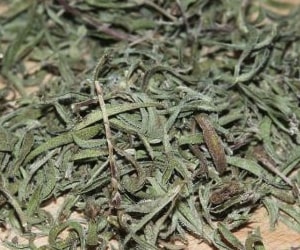
Savory herb leaves are the leaves of the savory plant, which is commonly used as a culinary herb. There are two main varieties of savory used in cooking: Summer Savory (Satureja hortensis) and Winter Savory (Satureja montana). Both varieties have aromatic leaves with a peppery and slightly pungent flavor. Here are some key points about savory herb leaves:
Characteristics:
- Appearance:
- Savory herb leaves are small, narrow, and lance-shaped. They are usually green, with a smooth texture.
- Aroma and Flavor:
- The leaves of both summer and winter savory have a peppery and savory flavor. Summer savory is milder, while winter savory tends to be more robust.
- Culinary Uses:
- Savory leaves are used to season a variety of dishes, including soups, stews, sauces, bean dishes, and meat preparations. The leaves can be used fresh or dried.
Culinary Application:
- Fresh Savory Leaves:
- Fresh savory leaves can be chopped and added to salads, marinades, and as a finishing touch to various dishes.
- Dried Savory Leaves:
- Dried savory leaves are commonly used when fresh leaves are not available. They can be added to spice blends, rubs, and infused oils.
- Pairings:
- Savory pairs well with beans, lentils, potatoes, meats, and vegetables, adding depth and flavor to a wide range of recipes.
Growing and Harvesting:
- Growing Conditions:
- Savory is a hardy herb that prefers well-drained soil and full sunlight. It can be grown in herb gardens, containers, or as part of a mixed garden.
- Harvesting:
- Leaves can be harvested throughout the growing season. For the best flavor, harvest the leaves just before the plant starts to flower.
Culinary Substitutes:
- If savory leaves are not available, thyme or marjoram can be used as substitutes in recipes, though the flavor may differ.
Health Benefits:
- Savory, like many herbs, contains essential oils and compounds that may have potential health benefits. It has been traditionally used in herbal medicine for various purposes.
Caution:
- Savory leaves are generally safe when used in culinary amounts. However, individuals with certain medical conditions or allergies should exercise caution and consult with a healthcare professional.
Savory herb leaves contribute a unique and savory flavor to dishes, making them a popular choice in various cuisines. Whether used fresh or dried, savory leaves enhance the taste of a wide range of recipes, adding depth and complexity to the overall flavor profile.
- Type – Fresh or dried herb leaf.
- Characteristics – Fragrant herb of the mint family. Available in summary savory or Winter Savory, Summer Savory is preferred more.
- Used in – Salads, eggs, vegetables, stuffings, soups, meats, fish, and sauces.
39. Sesame
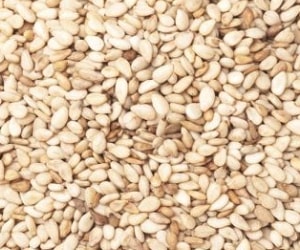
Sesame refers to a flowering plant (Sesamum indicum) grown for its seeds, which are commonly used in cooking, baking, and oil production. The seeds are small, flat, and oval, and they come in a variety of colors, including white, black, and brown. Here are some key points about sesame:
Sesame Seeds:
- Varieties:
- White Sesame Seeds: These are the most common variety, known for their mild and nutty flavor.
- Black Sesame Seeds: These have a more robust flavor and are often used in Asian cuisines, both sweet and savory.
- Brown Sesame Seeds: These fall somewhere between white and black sesame seeds in terms of flavor.
- Flavor Profile:
- Sesame seeds have a rich, nutty taste, especially when toasted. They can be used in both sweet and savory dishes.
- Culinary Uses:
- Sesame seeds are a versatile ingredient used in a variety of dishes, including bread, rolls, pastries, salads, stir-fries, and desserts. Tahini, a paste made from ground sesame seeds, is also widely used in Middle Eastern cuisine.
- Tahini:
- Tahini is a creamy paste made from roasted sesame seeds. It is a key ingredient in dishes like hummus and is used as a spread or sauce.
Sesame Oil:
- Types:
- Toasted Sesame OilSeveral kinds of oil are used to make salad dressing;e.g. olive; peanut; sunflower; walnut; grape se...: This oil has a strong, nutty flavor and is often used as a finishing oil in Asian cuisine.
- Light Sesame Oil: This oil has a milder flavor and is suitable for cooking. It is often used in stir-frying.
- Culinary Uses:
- Sesame oil is used for cooking, sautéing, and as a flavor enhancer in various dishes, especially in Asian and Middle Eastern cuisines.
- Toasted Sesame Oil:
- Often used in small quantities for its intense flavor, toasted sesame oil is a common addition to dressings, marinades, and noodle dishes.
Health Benefits:
- Sesame seeds are a good source of healthy fats, protein, vitamins, and minerals. They also contain antioxidants and may have potential health benefits.
- Sesame oil is rich in monounsaturated and polyunsaturated fats, and it contains vitamin E and other beneficial compounds.
Allergies:
- Some individuals may be allergic to sesame. Allergic reactions can range from mild to severe, and sesame allergens can be present in various food products.
Storage:
- Store sesame seeds in a cool, dark place in an airtight container to prevent them from turning rancid.
- Sesame oil should be stored in a cool, dark place, and once opened, it is best kept in the refrigerator to extend its shelf life.
Sesame seeds and sesame oil are valued for their unique flavor and versatility in the kitchen. From sprinkling seeds on salads to using sesame oil in cooking, they add depth and richness to a variety of dishes across different cuisines.
- Type – Whole or seed.
- Characteristics – Small yellowish seed with a nutty taste. High oil content produced in Asia.
- Used in – Can be roasted and used in bread, rolls, salads, oriental cuisine, etc.
40. Tarragon
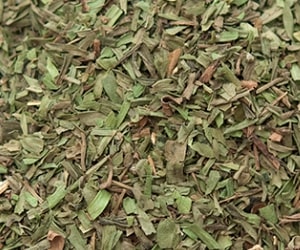
Tarragon (Artemisia dracunculus) is a perennial herb with narrow, lance-shaped leaves that belong to the sunflower family (Asteraceae). Known for its distinctive flavor, tarragon is widely used in culinary applications, particularly in French cuisine. Here are some key points about tarragon:
Culinary Uses:
- Flavor Profile:
- Tarragon has a unique flavor that is often described as sweet, slightly anise-like, and with a hint of pepper.
- Culinary Pairings:
- Tarragon pairs well with chicken, fish, eggs, vegetables, and is a key ingredient in the classic French sauce béarnaise.
- Herb Vinegar:
- Tarragon is commonly used to infuse vinegar, creating a flavorful herb vinegar that can be used in dressings and marinades.
- Tarragon Butter:
- Tarragon-infused butter is a popular preparation used to add flavor to grilled meats or steamed vegetables.
Varieties:
- French Tarragon (Artemisia dracunculus var. sativa):
- This is the culinary tarragon prized for its superior flavor. It is the variety commonly used in cooking.
- Russian Tarragon (Artemisia dracunculus var. inodora):
- This variety has a milder flavor and is not as highly regarded for culinary use. It lacks the distinct anise-like notes of French tarragon.
Growing Tarragon:
- Tarragon is a perennial herb that can be grown in well-drained soil and prefers full sunlight. It can be propagated through division or grown from seeds.
- French tarragon is often grown as it does not produce viable seeds, and propagation is typically done through root division.
Culinary Substitutes:
- While there is no exact substitute for the unique flavor of tarragon, some alternatives include fennel fronds, dill, or a combination of basil and anise.
Health Benefits:
- Tarragon contains certain compounds that may have antioxidant properties.
- It has been used in traditional medicine for its potential digestive and mild sedative effects.
Storage:
- Fresh tarragon can be stored in the refrigerator for a short period. To extend its life, you can store it with stems in a glass of water, covered with a plastic bag.
- Dried tarragon can be stored in a cool, dark place in an airtight container.
Caution:
- Tarragon is generally safe when used in culinary amounts. However, concentrated tarragon oil or supplements should be used with caution, and excessive consumption should be avoided during pregnancy.
Tarragon’s unique and nuanced flavor makes it a prized herb in the culinary world. Whether used to enhance the flavor of sauces, dressings, or various dishes, tarragon adds a distinctive and delightful element to a variety of recipes.
- Type – Fresh, dried, pickled, herb leaf.
- Characteristics – Delicate green herb that is both mint & licorice-like. Small oblong leaf.
- Used in – BearnaiseBéarnaise (bare-nayz) - A sauce made of butter and egg yolks and flavoured with a reduction of vine... sauce, Tarragon vinegar, chicken, fish, salads, dressings, and eggs.
41. Thyme
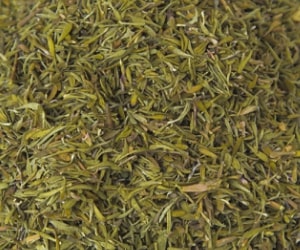
Thyme (Thymus vulgaris) is a fragrant and versatile herb that belongs to the mint family (Lamiaceae). It is widely used in culinary applications, traditional medicine, and as an ornamental plant. Thyme is known for its small leaves and robust flavor. Here are some key points about thyme:
Culinary Uses:
- Flavor Profile:
- Thyme has a warm, earthy, and slightly minty flavor with subtle floral and citrus notes. The taste can vary slightly between different thyme varieties.
- Culinary Pairings:
- Thyme pairs well with a variety of dishes, including roasted meats, stews, soups, vegetables, and sauces.
- Herb Blends:
- Thyme is a common ingredient in herb blends like herbes de Provence and bouquet garni.
- Thyme Butter:
- Thyme-infused butter is used to add flavor to roasted meats, grilled vegetables, and other dishes.
Varieties:
- Common Thyme (Thymus vulgaris):
- This is the most widely used variety with small gray-green leaves and a classic thyme flavor.
- Lemon Thyme (Thymus x citriodorus):
- Lemon thyme has a citrusy fragrance and flavor, making it a great addition to poultry, fish, and summer dishes.
- Orange Thyme (Thymus fragrantissimus):
- Orange thyme has a subtle orange aroma and is used in both savory and sweet dishes.
Growing Thyme:
- Thyme is a hardy perennial herb that prefers well-drained soil and full sunlight. It can be grown in containers, garden beds, or as a ground cover.
- Thyme is drought-tolerant and requires minimal care once established.
Culinary Substitutes:
- If thyme is not available, some suitable substitutes include oregano, marjoram, or savory, though each has its own distinct flavor.
Health Benefits:
- Thyme contains compounds with potential antioxidant and anti-inflammatory properties.
- It has been used in traditional medicine for respiratory and digestive issues.
Storage:
- Fresh thyme can be stored in the refrigerator for a short period. To extend its life, store it with stems in a glass of water, covered with a plastic bag.
- Dried thyme should be stored in a cool, dark place in an airtight container.
Caution:
- Thyme is generally safe when used in culinary amounts. However, concentrated thyme oil or supplements should be used with caution.
Thyme is a beloved herb in the kitchen, appreciated for its ability to enhance a wide range of dishes with its aromatic and flavorful leaves. Whether used fresh or dried, thyme adds depth and complexity to various recipes, making it a staple in many cuisines around the world.
- Type – Fresh or dried herb leaf, crushed or ground.
- Characteristics – Tiny brownish-green leaf, very aromatic.
- Used in – Soups, chowders, stocks, sauces, meats, poultry, salads, and dressings.
42. Turmeric
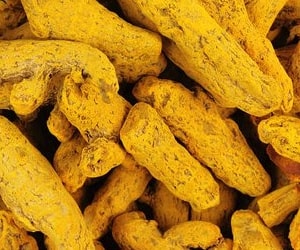
Turmeric (Curcuma longa) is a flowering plant belonging to the ginger family (Zingiberaceae). It is best known for its rhizomes, which are commonly used in cooking and have medicinal properties. The active compound responsible for turmeric’s distinctive yellow color and potential health benefits is curcumin. Here are some key points about turmeric:
Culinary Uses:
- Flavor Profile:
- Turmeric has a warm, slightly bitter taste with a hint of peppery and earthy notes.
- Coloring Agent:
- Turmeric is widely used as a natural coloring agent, adding a vibrant yellow color to dishes. It is a key ingredient in curry powders and gives mustard its yellow hue.
- Curry Dishes:
- Turmeric is a fundamental spice in Indian and Southeast Asian cuisines, especially in curry dishes. It is often used in combination with other spices.
- Golden Milk:
- Turmeric is used to make “golden milk,” a popular beverage made with turmeric, milk (or a plant-based alternative), and other spices.
Medicinal Uses:
- Curcumin:
- Curcumin, the active compound in turmeric, has antioxidant and anti-inflammatory properties.
- Traditional Medicine:
- Turmeric has been used in traditional medicine for various purposes, including the treatment of wounds, digestive issues, and inflammatory conditions.
- Supplements:
- Curcumin supplements are available, often taken for their potential health benefits. However, it’s essential to consult with a healthcare professional before using them.
Health Benefits:
- Anti-Inflammatory Properties: Curcumin is known for its anti-inflammatory effects, which may help in managing conditions related to inflammation.
- Antioxidant Activity: Turmeric exhibits antioxidant properties that can help neutralize free radicals in the body.
- Potential Joint Support: Some studies suggest that curcumin may have benefits for joint health.
Usage Tips:
- Bioavailability: Consuming turmeric with black pepper can enhance the absorption of curcumin in the body.
- Cooking: Use turmeric in various dishes such as curries, soups, stews, rice, and vegetable dishes.
- Tea and Beverages: Turmeric can be added to teas, smoothies, or golden milk for both flavor and potential health benefits.
Staining:
- Turmeric can stain surfaces, utensils, and clothing. Be cautious when handling it, and wash utensils and surfaces promptly.
Storage:
- Store fresh turmeric rhizomes in the refrigerator. Ground turmeric should be kept in a cool, dark place in an airtight container.
Caution:
- While turmeric is generally safe when used in moderate amounts in food, excessive intake may lead to digestive issues for some individuals.
- Individuals taking medications or with certain health conditions should consult with a healthcare professional before using turmeric supplements.
Turmeric’s rich color and unique flavor make it a popular spice in many cuisines. Beyond its culinary uses, it has gained attention for its potential health benefits, particularly due to the properties of curcumin. Incorporating turmeric into a balanced diet can add both flavor and a touch of potential wellness support.
- Type – Ground Spice
- Characteristics – An intense yellow root of the ginger family. Mild but peppery flavor.
- Used in – Curry powder, pickles, relish, salads, eggs, rice, Indian curries, etc.
43. Garlic
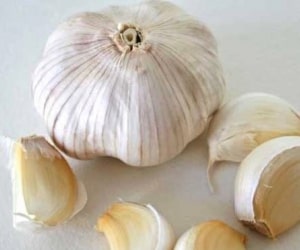
Garlic (Allium sativum) is a popular and widely used herb and vegetable known for its pungent flavor and various culinary and medicinal properties. It belongs to the Allium family, which also includes onions, leeks, and shallots. Here are some key points about garlic:
Culinary Uses:
- Flavor Profile:
- Garlic has a distinctive, pungent flavor with savory and slightly sweet undertones. When cooked, it becomes milder and sweeter.
- Versatility:
- Garlic is a versatile ingredient used in various cuisines around the world. It adds depth and richness to a wide range of dishes.
- Forms:
- Garlic is used in different forms, including fresh cloves, minced garlic, garlic powder, and garlic paste.
- Raw vs. Cooked:
- Raw garlic has a stronger and more pungent flavor, while cooked garlic is milder. It can be roasted, sautéed, or used in various cooking methods.
Culinary Applications:
- Sauces and Marinades:
- Garlic is a key ingredient in many sauces, marinades, and dressings, such as pesto, aioli, and vinaigrettes.
- Stir-Fries and Sautéed Dishes:
- Garlic is often used in stir-fries and sautéed dishes, adding flavor to vegetables, meats, and seafood.
- RoastedRoasted - Cooked uncovered without water added in an oven using dry heat. Garlic:
- Roasted garlic has a sweet and mellow flavor. It can be spread on bread, added to mashed potatoes, or used as a topping for various dishes.
- Pickled Garlic:
- Pickled garlic is enjoyed as a condiment and can be added to salads, sandwiches, or charcuterie boards.
Medicinal Uses:
- Traditional Medicine:
- Garlic has a long history of use in traditional medicine for various purposes, including its potential antibacterial and antiviral properties.
- Cardiovascular Health:
- Some studies suggest that garlic may have cardiovascular benefits, such as reducing blood pressure and cholesterol levels.
Health Benefits:
- Antioxidant Properties: Garlic contains compounds like allicin, which has antioxidant properties.
- Anti-Inflammatory: Garlic may have anti-inflammatory effects.
- Immune System Support: Garlic is believed to have immune-boosting properties.
Usage Tips:
- Fresh Garlic:
- Choose firm bulbs with tight skin when buying fresh garlic. Store in a cool, dry place.
- Minced Garlic:
- Minced garlic is convenient for quick cooking. It is available fresh, frozen, or in jars.
- Garlic Powder:
- Garlic powder is a convenient option for seasoning and is commonly used in spice blends.
Caution:
- Some individuals may be sensitive or allergic to garlic. Excessive consumption can lead to digestive discomfort for some people.
- If you have underlying health conditions or are taking medications, it’s advisable to consult with a healthcare professional.
Garlic’s robust flavor and culinary versatility have made it a staple in kitchens worldwide. Whether used to enhance savory dishes, provide health benefits, or simply add depth to various recipes, garlic remains a beloved and indispensable ingredient in the culinary world.
- Type – Fresh or dried. Used as a whole bulb in case of fresh and granulated powder or mixed with salt for dried garlic.
- Characteristics – Strong, aromatic member of the onion family.
- Used in – Used widely in many dishes or cooking.
44. Ginger
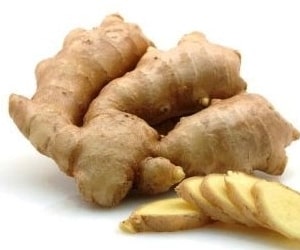
Ginger (Zingiber officinale) is a flowering plant whose rhizome, commonly known as ginger root, is widely used as a spice, flavoring agent, and traditional medicine. It belongs to the Zingiberaceae family, which also includes turmeric and cardamom. Here are some key points about ginger:
Culinary Uses:
- Flavor Profile:
- Ginger has a warm, pungent, and slightly sweet flavor with a hint of citrus. It adds a distinctive taste to both sweet and savory dishes.
- Forms:
- Ginger is available in various forms, including fresh ginger root, dried ginger powder, pickled ginger, crystallized ginger, and ginger oil.
- Cooking Methods:
- Ginger can be used in a variety of cooking methods, including grating, slicing, mincing, or using it in the form of a paste. It can be added to stir-fries, soups, curries, marinades, and baked goods.
- Beverages:
- Ginger is used to make ginger tea, ginger ale, and other beverages. It is a common ingredient in traditional chai blends.
Medicinal Uses:
- Anti-Inflammatory Properties:
- Ginger contains bioactive compounds with anti-inflammatory effects, which may help in managing inflammation.
- Digestive Aid:
- Ginger is known for its potential to alleviate nausea, aid digestion, and reduce symptoms of motion sickness.
- Cold and Flu Relief:
- Ginger tea is often consumed to soothe symptoms of colds and flu. It may help relieve sore throat and congestion.
Health Benefits:
- Antioxidant Properties: Ginger contains antioxidants that can help neutralize free radicals in the body.
- Anti-Nausea: Ginger is known for its anti-nausea properties, making it useful for alleviating nausea caused by various conditions, including pregnancy and chemotherapy.
- Pain Relief: Some studies suggest that ginger may have pain-relieving properties and could be beneficial for managing certain types of pain.
Usage Tips:
- Fresh Ginger:
- Choose ginger with smooth, taut skin. Fresh ginger can be stored in the refrigerator for an extended period.
- Ginger Paste:
- Ginger paste is a convenient option for quick cooking. It can be found in jars or made by blending fresh ginger with water.
- Dried Ginger:
- Ground ginger is used in baking and spice blends. However, its flavor is more concentrated than fresh ginger.
Caution:
- While ginger is generally safe for most people, excessive intake may cause digestive discomfort for some individuals.
- Consult with a healthcare professional if you are pregnant, nursing, or have any underlying health conditions before consuming ginger supplements in large amounts.
Ginger’s versatility, distinctive flavor, and potential health benefits make it a popular ingredient in various cuisines and traditional remedies worldwide. Whether used in savory dishes, desserts, or beverages, ginger adds a unique and aromatic element to a wide range of recipes.
- Type – Spice, fresh whole, dried powder, candied crystallized or pickled.
- Characteristics – Light brown knobby root from the tropical plant.
- Used in – Baked goods, desserts, fruits, curry dishes, pickling, chutney, Chinese and Asian cuisine, etc.
